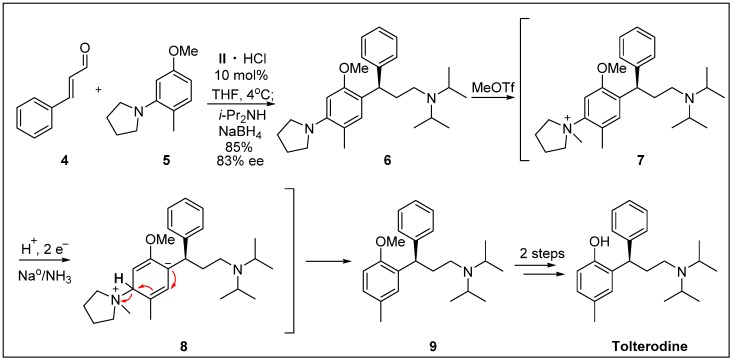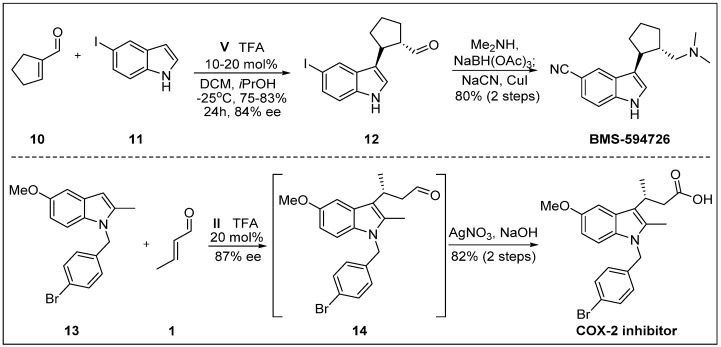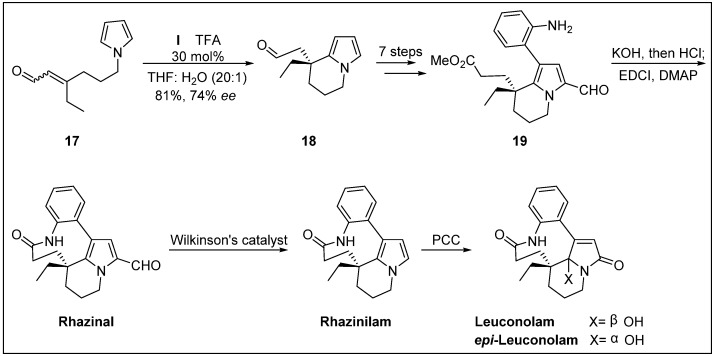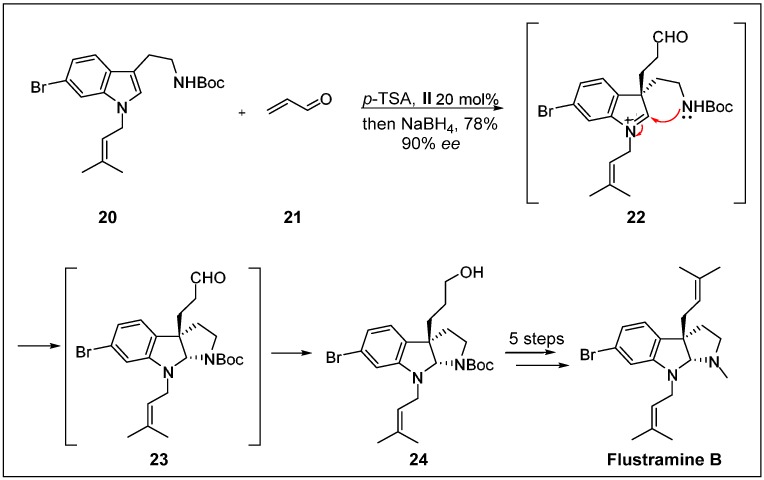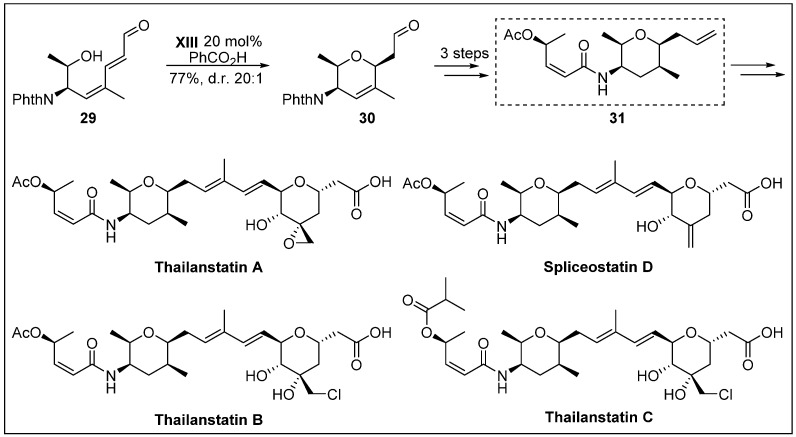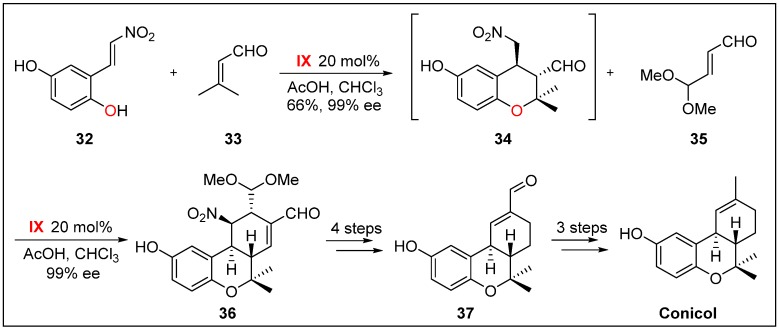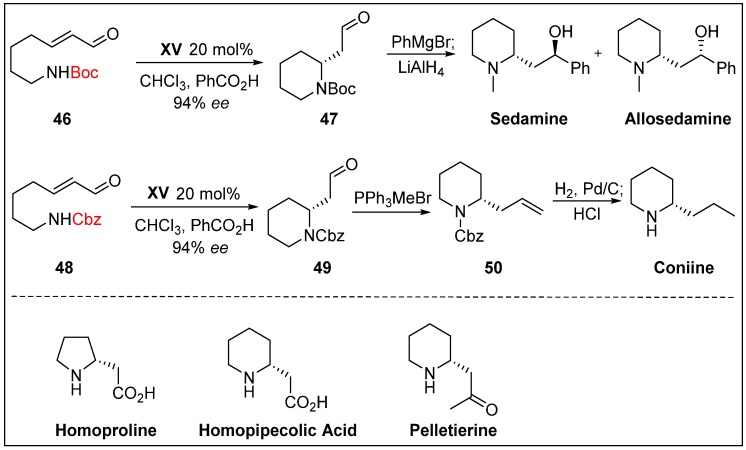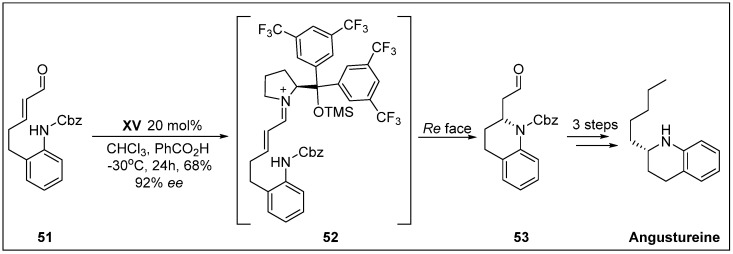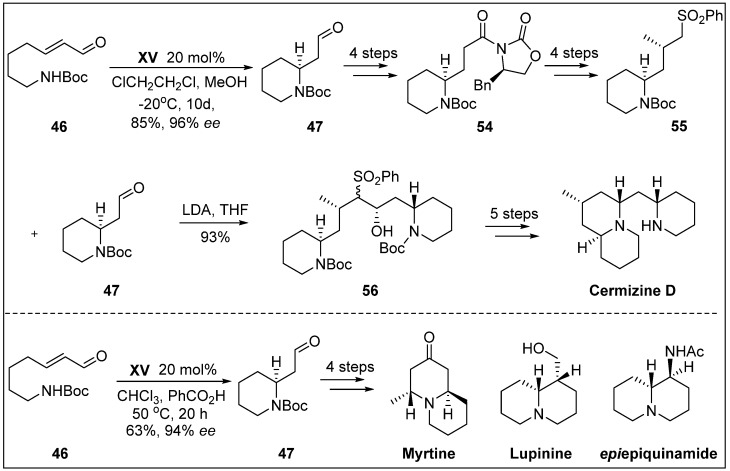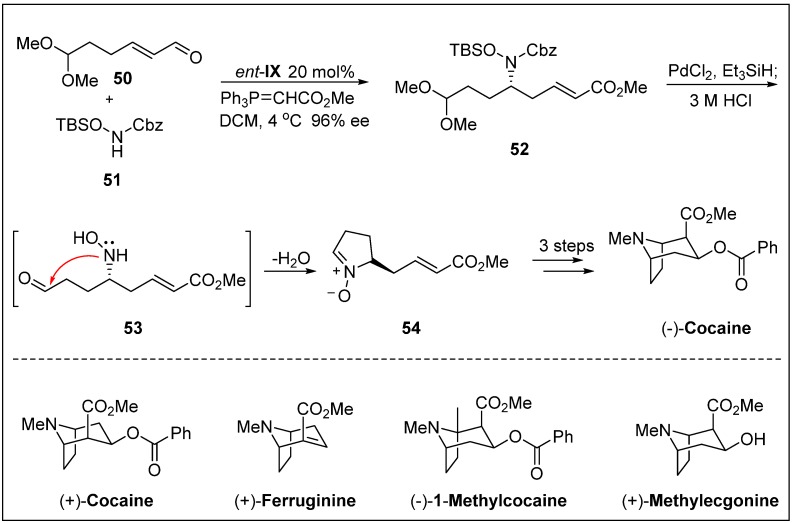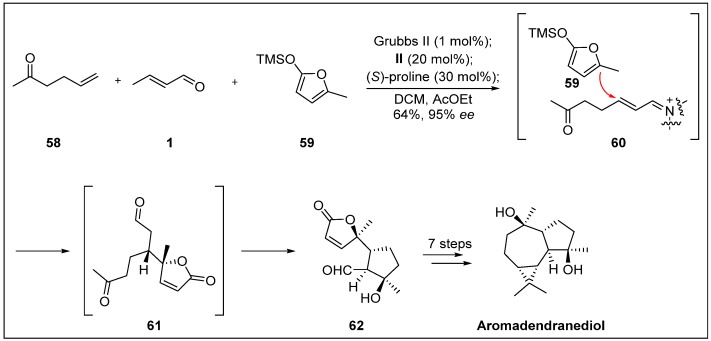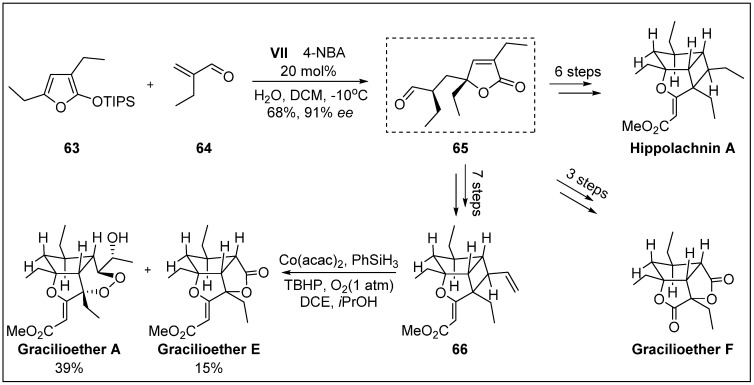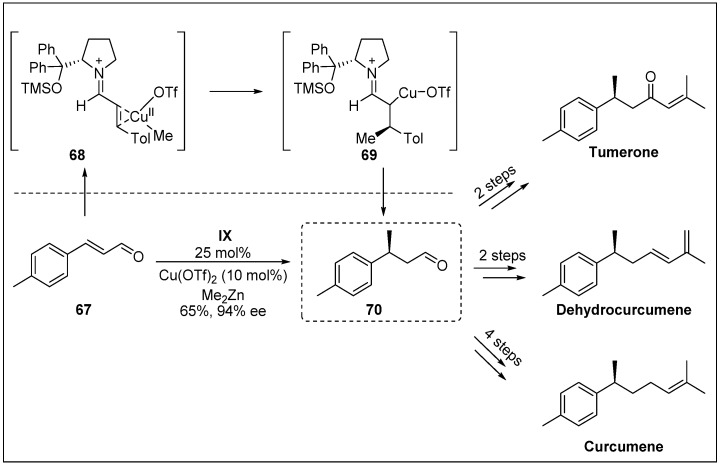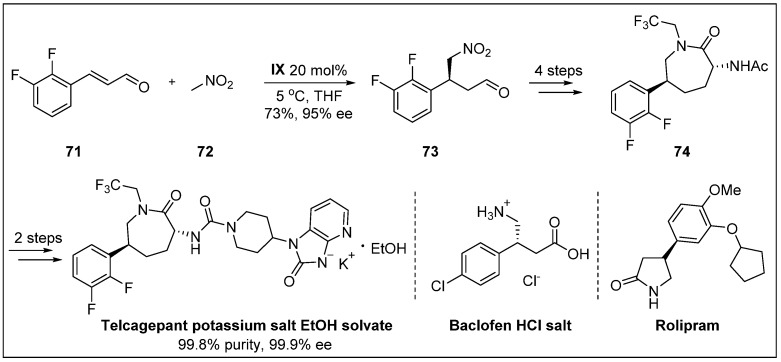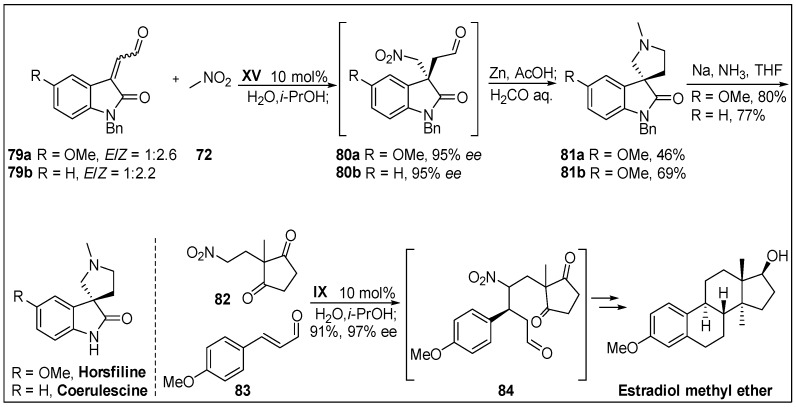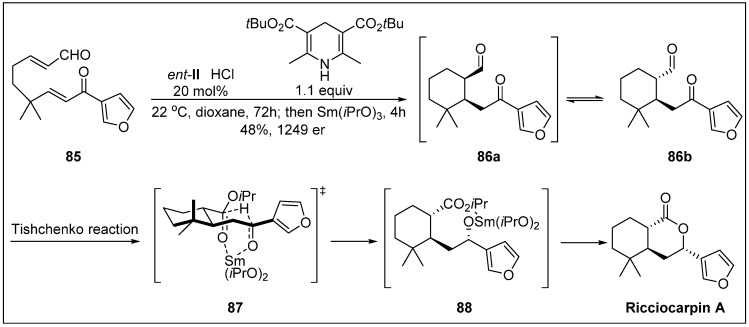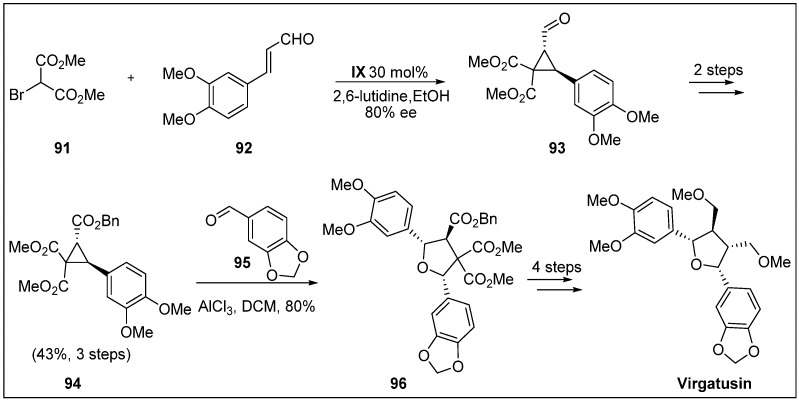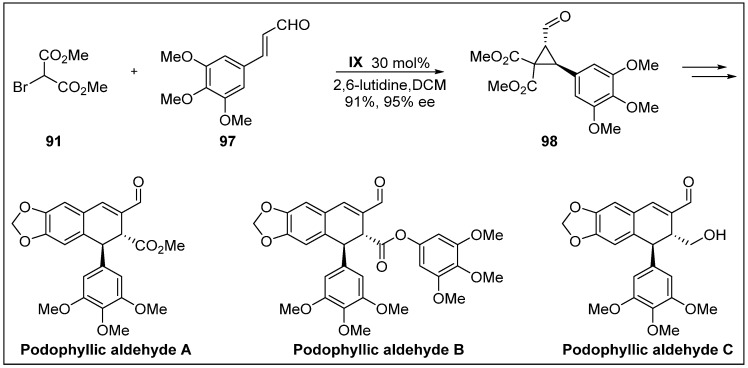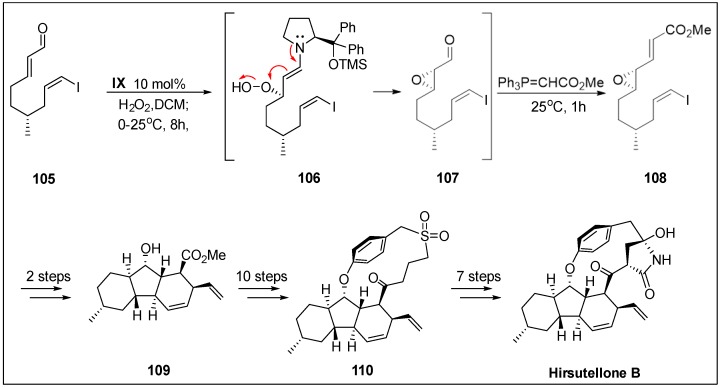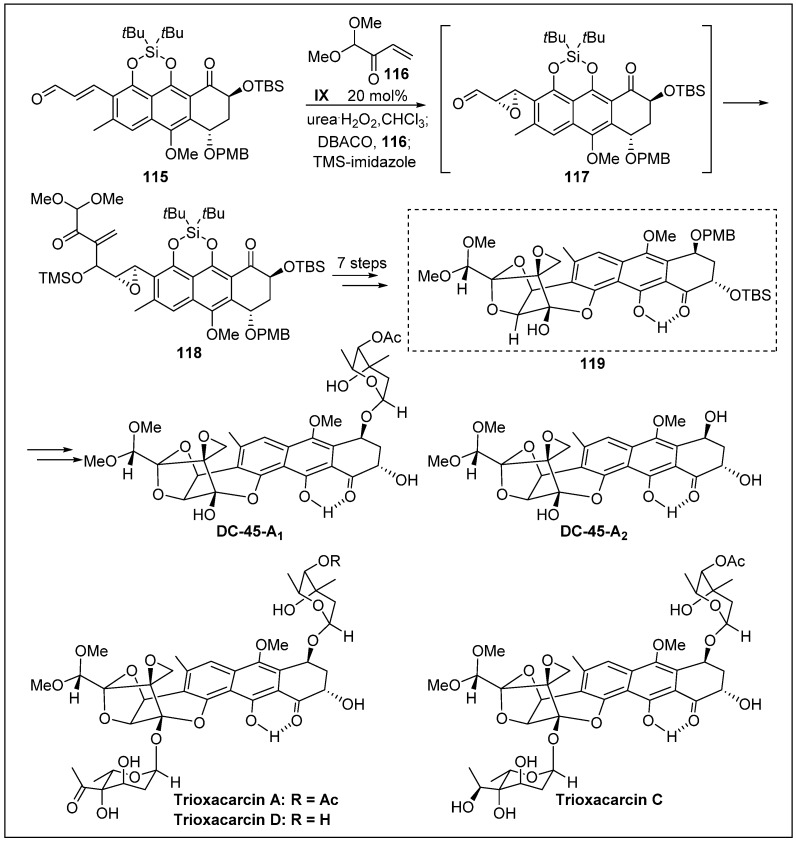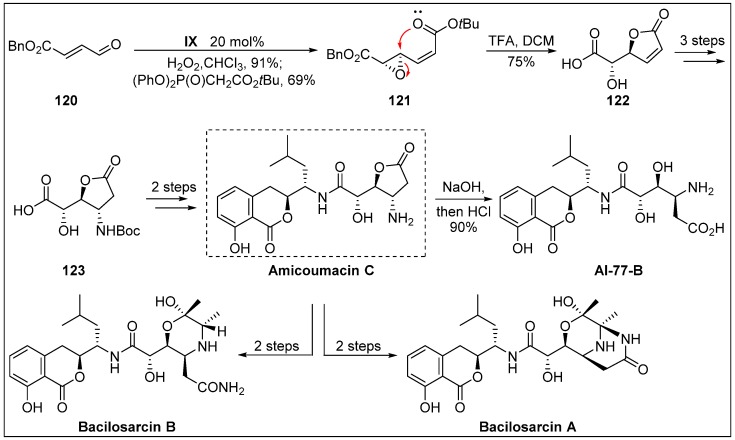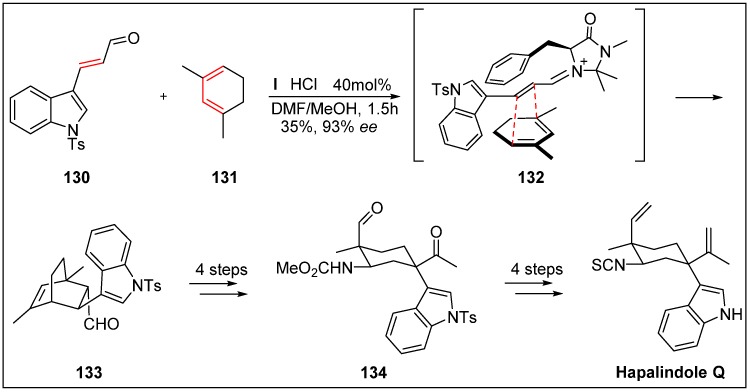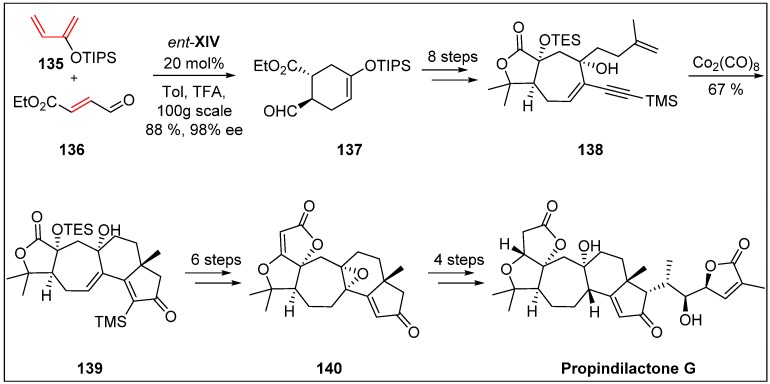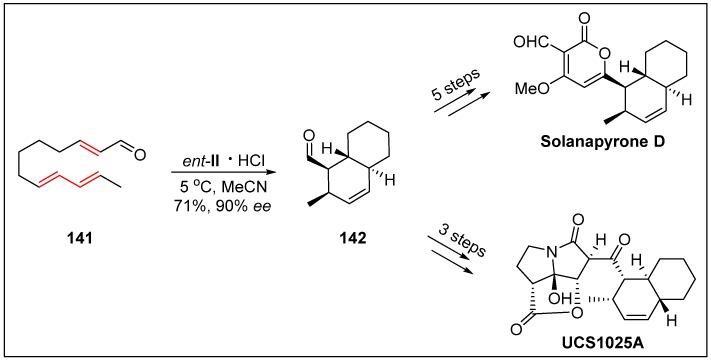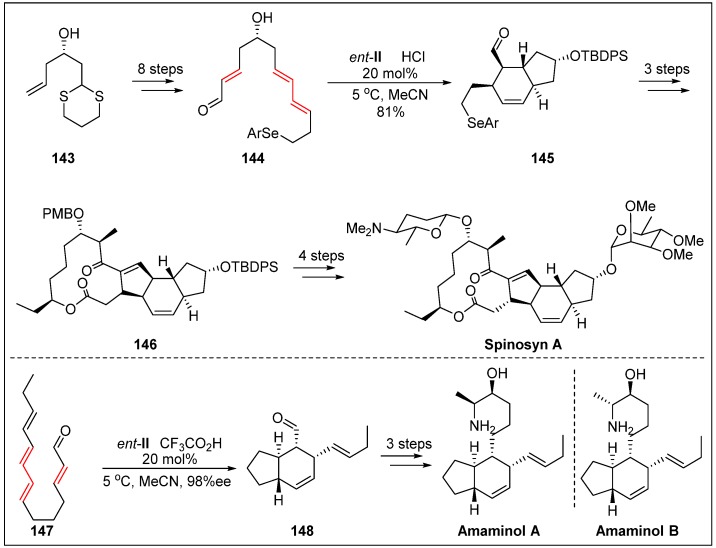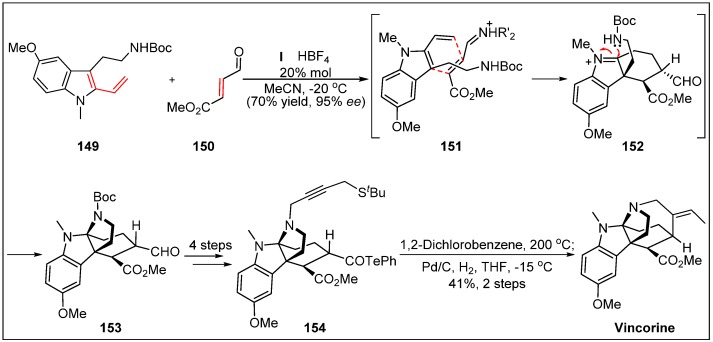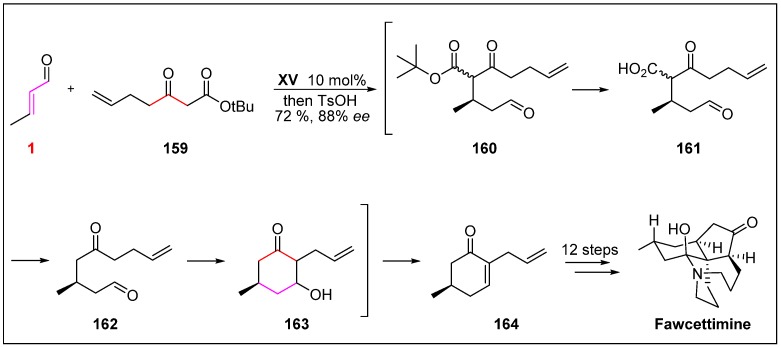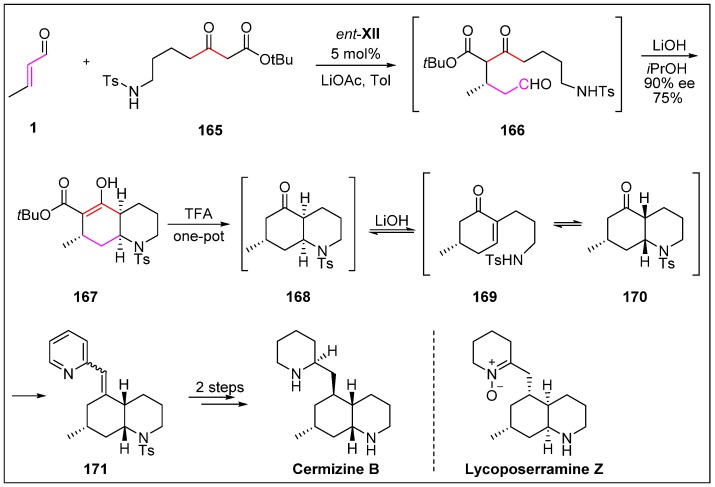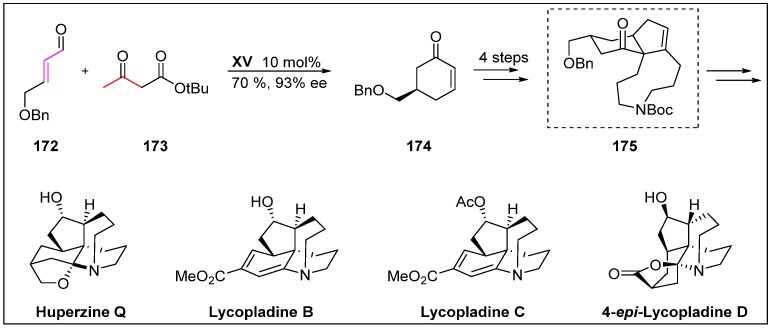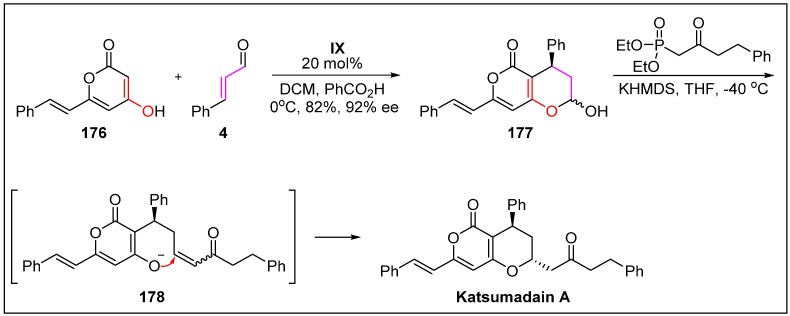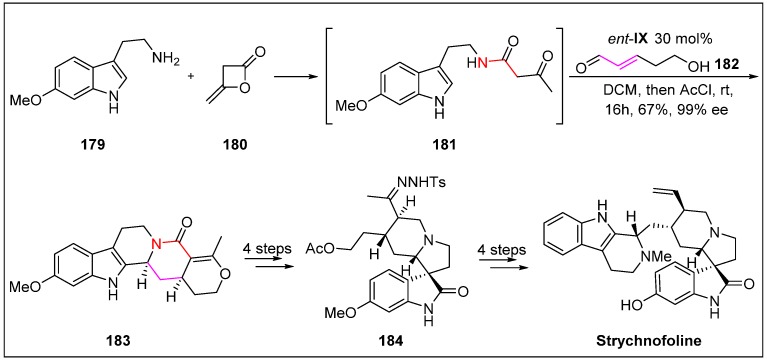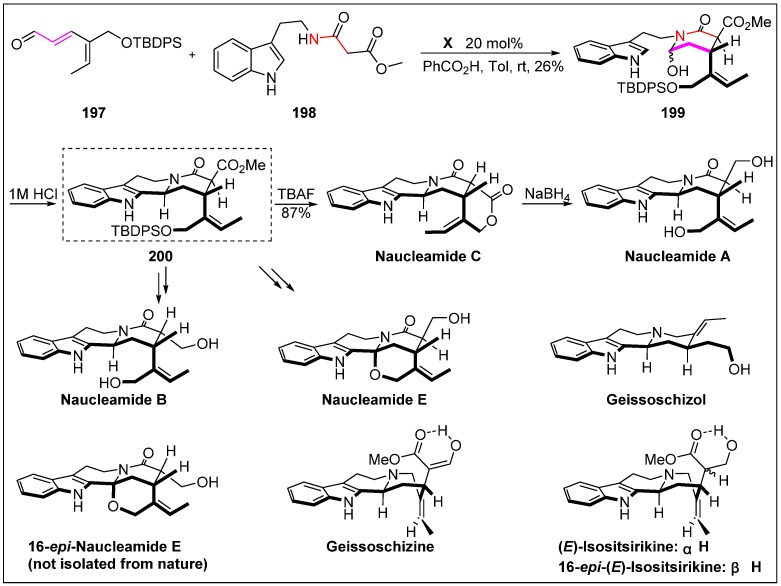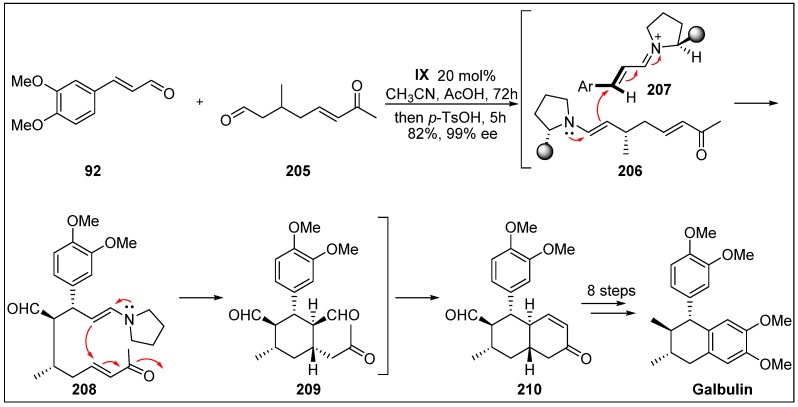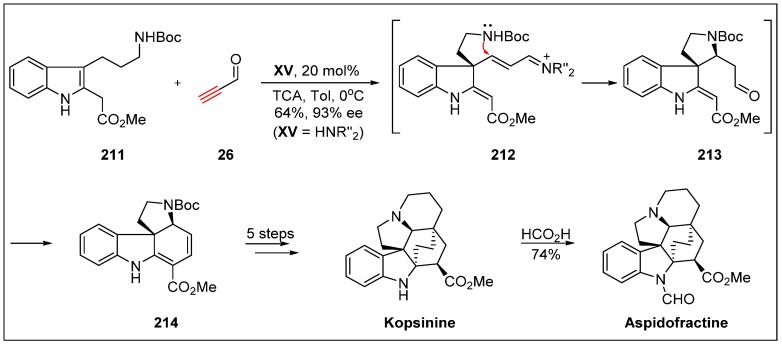Abstract
Chirality is one of the most important attributes for its presence in a vast majority of bioactive natural products and pharmaceuticals. Asymmetric organocatalysis methods have emerged as a powerful methodology for the construction of highly enantioenriched structural skeletons of the target molecules. Due to their extensive application of organocatalysis in the total synthesis of bioactive molecules and some of them have been used in the industrial synthesis of drugs have attracted increasing interests from chemists. Among the chiral organocatalysts, chiral secondary amines (MacMillan’s catalyst and Jorgensen’s catalyst) have been especially considered attractive strategies because of their impressive efficiency. Herein, we outline advances in the asymmetric total synthesis of natural products and relevant drugs by using the strategy of chiral secondary amine catalyzed reactions of α,β-unsaturated aldehydes in the last eighteen years.
Keywords: bioactive natural products; pharmaceuticals; asymmetric total synthesis; chiral secondary amines; α,β-unsaturated aldehydes
1. Introduction
In 2000, the MacMillan group [1] first described the fundamental concept of LUMO-lowering iminium-ion activation. In 2005, the Jørgensen group [2,3] reported diarylprolinol silyl ether catalysts, which have also been used in iminium-ion catalysis. Since then, chiral secondary amines catalysts (shown in Scheme 1a, including both MacMillan’s catalyst and Jorgensen’s catalyst, not including proline) have been intensively investigated by many groups, becoming one of the most successful areas of organic chemistry [4] and medicinal chemistry [5].
Scheme 1.
Chiral secondary amines and iminium catalytic cycle.
α,β-Unsaturated aldehydes are ubiquitous substrates in the area of asymmetric synthesis. The related mechanistic pathway of catalytic cycle [6,7] for iminium-ion activation is shown in Scheme 1b. The catalytic cycle consists of four principle steps: the first step is formation of the active iminium ion; the second step is conjugate addition reaction (or cycloaddition reaction); the next step is imine formation reaction; the last step is hydrolysis of iminium ion. Of note, the high enantioselectivity was obtained via nucleophiles added to the unshielded Re-face of the optically active E-configured iminium ion intermediate formed by the chiral secondary amine catalyst and the α,β-unsaturated aldehydes (steric hindrance plays an important role in directing the incoming nucleophile).
Over the past eighteen years, iminium ion activation strategy has extended into the synthesis of complex molecules including natural products and pharmaceuticals. Given the importance of the chiral secondary amines catalysts it is no doubt there have been a lot of reviews on organocatalysis [8,9,10,11,12,13,14]. But the relatively complete review on the total synthesis of natural products and relevant drugs published from 2002 to 2018 by using the strategy of chiral secondary amines catalyzed reactions of α,β-unsaturated aldehydes is still necessary. The present review will focus on the applications of relatively LUMO-lowering catalysis strategy in total synthesis (not including formal synthesis) of natural products.
2. Asymmetric Total Synthesis of Bioactive Natural Products and Pharmaceuticals
2.1. Friedel-Crafts Alkylation Reaction
The organocatalytic asymmetric Friedel-Crafts alkylation reaction has without question received extensive attention and has evolved to become an important tool in the area of asymmetric total synthesis [15]. As a burgeoning powerful tool, MacMillan’s catalyst is being widely exploited in several important enantioselective reactions, especially in Friedel-Crafts alkylation reactions. The application of chiral secondary amine catalyst in Friedel-Crafts reactions usually requires an electron-rich aromatic compound. It might be pointed out that an acidic co-catalyst may also have an important influence on the enantioselectivity of the asymmetric Friedel-Crafts alkylation reaction.
Organocatalytic Friedel-Crafts reactions offer an extraordinarily direct strategy for the straightforward single-step generation of the benzylic chiral center. In 2005, the Kim group [16] accomplished an enantioselective total synthesis of sesquiterpene phenol (+)-curcuphenol (Scheme 2), which was isolated from Didiscus flavus [17] and exhibited powerful antifungal activity [18]. The Kim group introduced the stereocenter by a highly enantioselective Friedel-Crafts alkylation reaction.
Scheme 2.
Total synthesis (+)-curcuphenol.
The key sequence highlighted the use of MacMillan’s catalyst ent-II in the presence of crotonaldehyde (1), N,N-dibenzyl-3-anisidine (2) and DCM to achieve aldehyde 3 with excellent enantioselectivity (90% ee). Further transformations afforded (+)-curcuphenol by a seven-step sequence including Sandmeyer-type bromination and Negishi-type coupling.
Another impressive example showing the versatility of this methodology was reported in 2009 by the MacMillan group [19] in the excellent total synthesis of bladder-selective antimuscarinic agent (+)-tolterodine (Detrol®, Scheme 3). Tolterodine is the first muscarinic receptor antagonist developed to treat overactive bladder [20]. The group employed an enantioselective organocatalytic alkylation of aniline with α,β-unsaturated aldehyde developed by the same group in 2002.
Scheme 3.
Total synthesis of (+)-tolterodine.
This key sequence involved the use of MacMillan’s catalyst II in the presence of α,β-unsaturated aldehyde 4, aniline 5, and THF to achieve β-branched aldehyde in 88% yield with 83% ee via a Friedel-Crafts alkylation. Remarkably, a reductive amination reaction rapidly occurred upon treating the β-branched aldehyde with i-Pr2NH using NaBH4 as a reducing agent to afford tertiary amine 6 in 97% yield. Further transformations afforded the pharmaceutical agent (+)-tolterodine by a three-step sequence including an aryl ammonium reduction (Na0/NH3) devised by the same group.
Indoles represent another important type of nucleophiles that has been widely used in Friedel-Crafts reactions. In 2005, Bristol Myers Squibb [21] developed an excellent 3-step total synthesis of selective serotonin reuptake inhibitor (+)-BMS-594726 (Scheme 4), which is the first example of α-branched α,β-unsaturated aldehyde being used as electrophile in an organocatalytic Friedel-Crafts alkylation.
Scheme 4.
Total synthesis of (+)-BMS-594726 and COX-2 inhibitor.
This key sequence highlighted the use of MacMillan’s catalyst V in the presence of α-branched α,β-unsaturated aldehyde 10, 5-iodoindole (11), iPrOH and DCM to obtain aldehyde 12 with 84% ee. Further transformations afforded (+)-BMS-594726 on 11.3 g scale by a simple two-step sequence including reductive amination and subsequent Buchwald cyanation. In addition, the MacMillan group [22] reported an excellent two-step total synthesis of COX-2 inhibitor (Scheme 4) in 87% ee via their own developed organocatalytic Friedel-Crafts indole alkylation protocol.
In 2010, the MacMillan group [23] reported another excellent three-step total synthesis of sesquiterpene (+)-frondosin B (Scheme 5), which had been first isolated from Dysidea frondosa in 1997 [24] and exhibited potential anti-HIV activity [25]. The group employed a novel organocatalytic Michael addition for the construction of its stereogenic center.
Scheme 5.
Total synthesis of (+)-frondosin B.
This key sequence highlighted the use of MacMillan’s catalyst in the presence of α,β-unsaturated aldehyde 1, activated boronate species 15 [26], dichloroacetic acid and EtOAc to achieve aldehyde in 84% yield with excellent enantioselectivity (93% ee). Final transformation from to (+)-frondosin B was achieved by a very efficient two-step procedure including allylic alkylation, allylic Friedel-Crafts alkylation, olefin isomerization, and demethylation (the last three transformations counted as one step). This novel organocatalytic approach culminated in the shortest asymmetric total synthesis of (+)-frondosin B to date [27]. This impressive example that perfectly illustrates the power of Friedel-Crafts reaction in the asymmetric total synthesis of natural products.
In 2006, the Banwell group [28] accomplished the enantioselective total synthesis of four alkaloids (−)-rhazinal, (−)-rhazinilam, (−)-leuconolam, and (+)-epi-leuconolam with reasonable enantioselectivity (Scheme 6) via organocatalytic intramolecular Friedel-Crafts reactions.
Scheme 6.
Total synthesis of (−)-rhazinal, (−)-rhazinilam, and (−)-leuconolam.
Although the above interesting targets are structurally complex, the key precursor aldehyde 18 only contains one stereocenter, which can be introduced by carrying out a chiral secondary amine I-catalyzed Friedel-Crafts alkylation of the starting material 17.
In 2004, the MacMillan group [29] accomplished the first enantioselective total synthesis of the pyrroloindoline alkaloid (−)-flustramine B (Scheme 7), which was isolated from the bryozoan Flusta foliacea [30]. This work provides a rapid and straightforward methodology for the stereoselective construction of its quaternary carbon stereocenters for the first time (indeed, before is work, only two racemic syntheses of flustramine B had been reported).
Scheme 7.
Total synthesis of (-)-flustramine B.
The key strategy in this elegant total synthesis was a highly enantioselective cascade Friedel-Crafts/cyclization reaction. This sequence highlighted the use of MacMillan’s catalyst II in the presence of α,β-unsaturated aldehyde 21, and 6-bromotryptamine derivative 20 to obtain key tricyclic intermediate 23, which was reduced using NaBH4 to achieve key tricyclic intermediate 24 in 78% yield with excellent enantioselectivity (90% ee). After five additional steps, the total synthesis of (−)-flustramine B was accomplished. The key sequence included a H2O2-mediated selenoxide elimination, Grubbs olefin metathesis reaction and reduction. It is worth mentioning that the above case is the first application of organocatalytic cascade strategy in synthesis of natural products.
In 2011, the MacMillan group [31] developed an excellent 20-step total synthesis of the 12-membered macrocycle (−)-diazonamide A (Scheme 8), which was isolated initially from the ascidian Diazona angulata. in 1991 by the Fenical group [32] and exhibited powerful antimitotic activity [33]. The key strategy in this elegant total synthesis was a highly enantioselective cascade Friedel-Crafts/cyclization reaction.
Scheme 8.
Total synthesis of (−)-diazonamide A.
The unique triaryl-substituted quaternary stereocenter at C-10 makes this compound an especially challenging target for synthesis. The key sequence highlighted the use of MacMillan’s catalyst in the presence of alkynal 26, indole derivative 25, TCA, MeOH, CHCl3, and PhMe to achieve tricyclic intermediate 28 in 86% yield with high stereoselectivity (>20:1 dr) via intermolecular Friedel-Crafts reaction, followed by an intramolecular nucleophilic addition of 27. Further transformations afforded (−)-diazonamide A by a thirteen-step sequence, making it another impressive example of organocatalytic cascade strategy.
2.2. Michael Addition Reaction
Organocatalytic asymmetric Michael addition reaction is one of the most general, convenient, powerful, and versatile tools for the formation of C-C bonds, C-N bonds, C-O bonds and so on [34]. It is interesting to note that Jorgensen’s catalyst has received much more extensive in the field of both asymmetric intramolecular and intermolecular Michael addition reactions.
2.2.1. Oxa-Michael Addition
Chiral secondary amine catalysts paved the way for an effective method for the asymmetric synthesis of valuable tetrahydropyran rings with excellent stereoselectivity. In 2016, the Nicolaou group [35] accomplished a short and efficient first total synthesis of spliceosome inhibitor thailanstatin A (Scheme 9), which had been first isolated from Thailandensis burkholderia MSMB43 in 2013 by the Cheng group [36] and exhibited significant cancer activity. The key reaction in this elegant total synthesis was a highly enantioselective intramolecular oxa-Michael addition.
Scheme 9.
Total synthesis of thailanstatins A-C and spliceostatin D.
After several preliminary steps, the synthetic precursor 29 of the key organocatalytic reaction could be prepared from the known Garner aldehyde starting material. Thus, when α,β,γ,δ-unsaturated aldehyde 29 was treated with catalyst XIII as well as benzoic acid in the presence of DCM at 0 °C, the intramolecular oxa-Michael addition proceeded in a highly enantioselective manner to produce tetrahydropyran ring 30 in 77% yield (dr > 20:1). Then advanced intermediate 31 was prepared through a sequence including stereoselective hydrogenation, methylenation and an amide formation reaction. Final transformation from amide 31 to thailanstatin A was achieved by a two-step sequence including cross metathesis and Suzuki cross-coupling. Further, thailanstatin B, thailanstatin C, spliceostatin D, and an array of analogues (Scheme 9) have been prepared by the Nicolaou group [37] in 2018 via the key organocatalytic intramolecular 1,4-addition strategy.
Organocatalytic three-component cascade reaction provides a straightforward entry to target molecule bearing three contiguous stereocenters. In 2010, the Hong group [38] described the first asymmetric total synthesis of (+)-conicol (Scheme 10), which had been first isolated from ascidian Aplidium conicum in 2002 by the Salvá group [39]. The key reaction in this elegant synthesis was a highly enantioselective three-component one-pot quadruple domino reaction, namely, oxa-Michael addition/Michael addition/Michael addition/aldol condensation.
Scheme 10.
Total synthesis of (+)-conicol.
This key sequence highlighted the use of Jorgensen’s catalyst IX in the presence of α,β-unsaturated aldehydes 33 and 35, (E)-2-(2-nitrovinyl)-benzene-1,4-diol (32), acetic acid, and CHCl3 to provide hexahydro-6H-benzo[c]chromene 36 with superb enantioselectivity (99% ee) via a domino oxa-Michael addition/Michael addition sequence of 32, followed by a domino nitro-Michael addition/aldol condensation of 34. Further transformations afforded (+)-conicol by a seven-step sequence including RhCl(PPh3)3 decarbonylation, hydrogenation, and metallic reduction.
α-Tocopherol is one of the most biologically significant members of the vitamin E family. In 2008, the Woggon group [40] published an high diastereoselective three-component cascade γ-functionalization/oxa-Michael addition reaction using chiral secondary amines catalyst ent-XIV (Scheme 11).
Scheme 11.
Total synthesis of α-tocopherol.
Mechanistically, the transformation occurs between aldehyde 38 and 40 via the intermediary formation of phenol ion 41, which is in turn readily trapped in an intramolecular way by the hydroxy group, giving rise to key intermediate 42. Then α-tocopherol was obtained successfully by a standard four step transformation.
In 2012, the Hong group and the Kim group [41] published the enantioselective total synthesis of 20-membered macrolide (+)-dactylolide (Scheme 12), which had been first isolated by the Riccio group in 2001 from a Dactylospongia sp. sponge and exhibited modest antitumor activity [42]. The key reaction in this elegant total synthesis was a highly enantioselective intramolecular 1,6-oxa Michael addition reaction.
Scheme 12.
Total synthesis of (+)-dactylolide.
Synthetic precursor 43 of the key conjugate addition reaction was prepared by a seven-step transformation from known 1,3-dithiane-2-ethanol. Then the key sequence highlighted the use of Jorgensen’s catalyst I in the presence of α,β,γ,δ-unsaturated aldehyde 43, benzoic acid, and toluene to achieve 2,6-cis-disubstituted methylene tetrahydropyran enal 44 in 98% yield with excellent stereoselectivity (>20:1 dr) via an organocatalytic oxa-Michael addition reaction. Further transformations gave rise to (+)-dactylolide via an eight steps sequence including intramolecular NHC-catalyzed oxidative macrolactonization reaction, Wittig olefination, and Dess-Martin oxidation.
2.2.2. Aza-Michael Addition
The Michael addition which uses a nitrogen negative-ion as donor to form the C-N bond, is called the aza-Michael addition. α-Substituted nitrogen-containing heterocycles bearing a stereocenter are another kind of natural products that can be converted efficiently using chiral secondary amines catalysts.
In 2007, the Fustero group [43] accomplished the enantioselective total syntheses of three piperidine alkaloids (Scheme 13), namely, (+)-allosedamine, (+)-sedamine, and (+)-coniine starting from similar precursors 47 and 49. Synthetic precursors were prepared via an organocatalytic asymmetric intramolecular aza-Michael reaction.
Scheme 13.
Total synthesis of (+)-sedamine, (+)-allosedamine, (+)-coniine, (−)-homoproline, (−)-homopipecolic acid, and (−)-pelletierine.
This asymmetric cyclisation reaction highlighted the use of Jorgensen’s catalyst XV in the presence of α,β-unsaturated aldehyde 46 (or 48), benzoic acid and CHCl3 to achieve piperidine aldehyde 47 (or 49) in excellent enantioselectivity (94% ee). Further transformations afforded the above three alkaloids by a simple two to four steps sequence.
In 2008, the Carter group [44] accomplished the enantioselective total syntheses of three other alkaloids, namely, (−)-homoproline, (−)-homopipecolic acid, and (−)-pelletierine using Jorgensen’s catalyst XV via the same organocatalytic asymmetric intramolecular aza-Michael reaction (Scheme 13). The same year, the Fustero group [45] also described the total synthesis of tetrahydroquinoline alkaloid (+)-angustureine (Scheme 14) using the above organocatalytic aza-Michael strategy.
Scheme 14.
Total synthesis of (+)-angustureine.
In 2012, the Carter group [46] accomplished the elegant total synthesis of piperidine alkaloid (+)-cermizine D (Scheme 15), which had been isolated in 2004 by the Kobayashi group [47] from the Chinese herbal medicine Lycopodium cernuum and exhibited modest cytotoxicity. The key reaction in this efficient synthesis was an enantioselective intramolecular aza-Michael reaction using almost the same protocol as the Fustero group.
Scheme 15.
Total synthesis of (+)-cermizine D, (+)-myrtine, and (−)-lupinine.
With piperidine 47 in hand, a subsequent eight-step transformation provided another precursor sulfone 55, which gave hydroxy sulfone 56 via deprotonation of sulfone 55 followed by addition of piperidine aldehyde 47. Further transformations afforded (+)-cermizine D by a five-step sequence including oxidation, reduction, desulfurization, and SN2 cyclization reaction. It is worth note that this short as well as practical total synthesis has proven to be an extremely powerful tool by taking advantage of the common intermediate strategy.
Moreover, the Fustero group [48] accomplished the enantioselective total syntheses of other three quinolizidine alkaloids, namely, (+)-myrtine, (−)-lupinine, and (+)-epiepiquinamide via the same asymmetric aza-Michael reaction (Scheme 15).
In 2011, the Hong group [49] reported the total synthesis of quinolizidine alkaloid (−)-epimyrtine (Scheme 16), which had been isolated from vaccinium myrtillus in 1981 by the Hootelé group [50] and exhibited potential anticancer activity [51].
Scheme 16.
Total synthesis of (−)-epimyrtine and (+)-myrtine.
The group employed an intramolecular highly stereoselective aza-Michael reaction for the construction of its 2,6-cis-piperidine block by taking advantage of an iminium activation strategy. In addition, (+)-myrtine has also been prepared from the common substrate.
In 2012, the Córdova group [52] described an excellent total synthesis of the tropane alkaloid (−)-cocaine (Scheme 17), which had been first isolated in 1895 by the Neiman group and exhibits powerful analgesic activity [53]. The group employed a highly enantioselective one-pot aza-Michael/Wittig reaction for the construction of its chiral building block.
Scheme 17.
Total synthesis of (−)-cocaine, (+)-cocaine, (+)-ferruginine, (−)-1-methylcocaine, and (+)-methylecgonine.
The key sequence highlighted the use of Jorgensen’s catalyst ent-IX in the presence of α,β-unsaturated aldehyde 50, hydroxylamine 51, phosphonium ylide and DCM to achieve α,β-unsaturated δ- amino acid 52 with excellent enantioselectivity (96% ee). Further transformations afforded (−)-cocaine by a five-step sequence including deprotection, cyclization, intramolecular 1,3-dipolar cycloaddition, hydrogenation, and benzoylation. In addition, the total synthesis of other four structurally related alkaloids, namely, (+)-cocaine, (+)-ferruginine, (−)-1-methylcocaine, and (+)-methylecgonine were prepared via this organocatalytic three-component tandem aza-Michael/Wittig reaction (Scheme 17).
2.2.3. Michael Addition
The Michael addition is one of the most important and classical reactions of organic chemistry. Organocatalytic enantioselective Michael addition reactions have been widely used as key steps of all kinds of important natural products and drugs.
The iminium-catalyzed enantioselective Mukaiyama-Michael addition reaction overcomes the deficiency of Lewis acids enabling 1,4-additions of silyloxy furans to α,β-unsaturated aldehydes. In 2003, the MacMillan group [54] reported an elegant four-step total synthesis of butenolide (−)-spiculisporic acid (Scheme 18), utilizing an unprecedented organocatalytic Mukaiyama-Michael addition reaction.
Scheme 18.
Total synthesis of (−)-spiculisporic acid.
Mechanistically, Mukaiyama-Michael addition of the silyloxyfuran 55 to the acceptor α,β-unsaturated aldehyde 56 catalyzed by MacMillan’s catalyst II furnished the key intermediate 57 in 90% yield with good enantioselectivity (89% ee).
In 2009, the MacMillan group [55] reported the elegant total synthesis of tricyclic sesquiterpene diol (−)-aromadendranediol (Scheme 19), which had been first isolated in 1978 from the coral Sinularia mayi by the Djerassi group [56]. The key reaction in this novel synthesis was a triple cascade cross-metathesis reaction/Mukaiyama-Michael addition/intramolecular aldol reaction.
Scheme 19.
Total synthesis of (−)-aromadendranediol.
Synthetic precursor 60 of the key conjugate addition was prepared by a cross-metathesis reaction of 58 with 1. Then the key sequence highlighted the use of MacMillan’s catalyst II in the presence of α,β-unsaturated aldehyde 60, silyloxyfuran 59, DCM, and EtOAc to achieve keto-aldehyde 61 with 95% ee. A subsequent intramolecular aldol addition afforded the advanced precursor 62. Further transformations gave rise to (−)-aromadendranediol via a seven step sequence including global reduction, chemoselective oxidation, and Wittig olefination.
In 2018, the group of Tang [57] accomplished the novel enantioselective total syntheses of four diverse Plakortin polyketides [58,59], namely, (+)-hippolachnin A, (+)-gracilioether A, (−)-gracilioether E and (−)-gracilioether F starting from the common precursor 65, which was afforded via organocatalytic Mukaiyama-Michael reaction (Scheme 20).
Scheme 20.
Total synthesis of (+)-hippolachnin A, (+)-gracilioethers A, E and F.
The key sequence highlighted the use of diphenylpyrrolidine catalyst in the presence of α,β-unsaturated aldehyde, silyloxyfuran, 4-NBA and DCM to achieve the common intermediate γ-butenolide in 68% yield with excellent enantioselectivity (91% ee). Further transformations afforded the abovementioned four tricyclic polyketides via a three to eight steps sequence including a biomimetic [2+2] photocycloaddition, and one-pot oxidative cleavage/Baeyer-Villiger rearrangement or an unprecedented hydrogen-atom-transfer (HAT)-triggered oxygenation.
In 2011, the Córdova group [60] accomplished the enantioselective total syntheses of three diverse bisabolane sesquiterpenes, namely, (+)-dehydrocurcumene, (+)-tumerone, and (+)-curcumene starting from the common precursor 70, which was prepared via co-catalytic asymmetric conjugate addition (Scheme 21).
Scheme 21.
Total synthesis of (+)-dehydrocurcumene, (+)-tumerone, and (+)-curcumene.
This asymmetric addition highlighted the use of catalyst IX in combination with Cu(OTf)2 in the presence of α,β-unsaturated aldehyde 67, dimethylzinc and THF to achieve 1,4-selective product 70 in 65% yield with excellent enantioselectivity (94% ee) via Cu(II)-alkyl complex 68 and subsequent selective 1,4-addition. Further transformations afforded the above three sesquiterpenes by a two to four steps sequence from the common precursor 70.
In 2010, the Xu group [61] reported an efficient total synthesis of a selective peptide receptor antagonist telcagepant (MK-0974) (Scheme 22), which is a migraine drug [62] developed by Merck & Co Inc.
Scheme 22.
Total synthesis of MK-0974, baclofen, and rolipram.
This key sequence highlighted the use of Jorgensen’s catalyst IX in the presence of α,β-unsaturated aldehyde 71, nitromethane (72), pivalic acid, boric acid and THF to give adduct 73 in 73% yield with excellent enantioselectivity (95% ee). The advanced precursor 74 was then obtained by a four-step sequence including a formal Doebner-Knoevenagel coupling, reduction and cyclization. Further transformations afforded telcagepant potassium salt EtOH solvate with near perfect enantioselectivity (99.9% ee). It is interesting to note that this is the first reported application case from laboratory scale to industrial scale, which shows the great potential of asymmetric iminium catalysis.
In addition, the Wang group [63] performed a 3-step total synthesis of the antispastic drug baclofen with 97% ee using the same strategy. Interestingly, the Palomo group [64] reported a 2-step total synthesis of type IV phosphodiesterase inhibitor (+)-rolipram via a new chiral secondary amine VIII using water as the only solvent.
Nitromethane is one of the most prominent nucleophiles used in Michael addition reactions. In 2017, the Hayashi group [65] successfully developed an excellent total synthesis of the most biologically active isomer (+)-beraprost (Scheme 23), which is a prostaglandin-like drug developed by Toray Industries Inc. [66]. This FDA-approved agent contains a unique benzofuran ring system and four contiguous stereogenic centers.
Scheme 23.
Total synthesis of (+)-beraprost.
As depicted in Scheme 23, mechanistically, the introduction of the tertiary stereocenter could be easily furnished by reacting crotonaldehyde (1) with nitromethane (72) in the presence of Jorgensen’s catalyst ent-XI. This strategy gave adduct 75 in 82% yield with excellent enantioselectivity (90% ee).
Further transformations afforded phosphonate 76 by a five-step sequence including an Ohira-Bestmann reaction, selective methylation, Nef reaction, benzyl esterification, and Claisen-type reaction. Another three-step transformation including a Horner-Wadsworth-Emmons reaction, diastereoselective 1,2-reduction, and subsequent hydrolysis afforded (+)-beraprost.
In 2014, the Hayashi group [67] accomplished an enantioselective total synthesis of spirooxyindole alkaloids (−)-horsfiline and (−)-coerulescine (Scheme 24). (−)-Horsfiline was first isolated from Horsfieldia superba in 1991 by the Bodo group [68], while (−)-coerulescine was isolated from Pharalis coerulescens in 1998 by the Colegate group [69].
Scheme 24.
Total synthesis of (−)-horsfiline, (−)-coerulescine, and estradiol methyl ether.
The key step in this elegant total synthesis was a highly enantioselective one-pot Michael addition/reductive amination/reductive amination sequence for the construction of the all-carbon quaternary stereogenic centers with excellent enantioselectivity. After the abovementioned one-pot four-reaction process, one further transformation afforded (−)-horsfiline and (−)-coerulescine. Another impressive total synthesis using this type of method was accomplished by the Hayashi group [70] in 2017. In their synthesis of estradiol methyl ether, the key step was a chiral secondary amine IX catalyzed Michael addition of nitroalkane 82 and cinnamaldehyde 83 (Scheme 24).
2.3. Hydrogenation
In 2009, the List group [71] develop a novel method for the perfectly redox-economic total synthesis of the furanosesquiterpene lactone (+)-ricciocarpin A (Scheme 25), which had been isolated from Ricciocarpos natans [72] and exhibited potent molluscicidal activity [73]. The above group employed a cascade reductive Michael/cycloisomerization/Tishchenko reaction for the rapid construction of its chiral centers.
Scheme 25.
Total synthesis of (+)-ricciocarpin A.
The synthetic precursor of the key organocatalytic reaction was obtained via an aldol condensation and cross-metathesis. Thus, when α,β-unsaturated aldehyde 85 was treated with catalyst ent-II as well as Hantzsch ester in the presence of dioxane at 22 °C, the reductive Michael reaction initially proceeded in a highly enantioselective (97% ee) manner to provide ketoaldehyde 86a. Remarkably, isomerization and Tishchenko reaction occurred rapidly upon treating the above reaction mixture with Sm(iPrO)3. This protecting-group-free 3-step total synthesis of (+)-ricciocarpin A shows the great potential of asymmetric iminium catalysis.
In 2011, the Willis group [74] reported the first total synthesis of polychlorinated compound (+)-dysideaproline E (Scheme 26), which had been isolated from marine sponge Dysidea sp. in 2001 by Harrigan group [75]. The Willis group employed an organocatalytic reductive Michael reaction to construct its chiral center.
Scheme 26.
Total synthesis of (+)-dysideaproline E.
Synthetic precursor 89 of the key organocatalytic reaction was obtained in two steps via a Horner-Wadsworth-Emmons reaction and DIBAL-H reduction. Thus, when α,β-unsaturated aldehyde 89 was treated with catalyst IV as well as Hantzsch ester in the presence of CHCl3 at −20 °C, the reductive Michael proceeded in a highly enantioselective (90% ee) to achieve dichloroaldehyde 90. Two further high yielding steps then gave (+)-dysideaproline E in an efficient and highly rapid procedure.
2.4. Cycloadditions
In comparison to the above conjugated addition, organocatalytic cycloaddition strategies also provide an effective methodology to produce key chiral intermediates for the construction of important natural products and drugs [76]. The related cycloaddition strategies mentioned below including cyclopropanations, epoxidations, Diels-Alder reactions, [3+2]-cycloadditions, and [3+3]-cycloadditions.
2.4.1. Cyclopropanations
Chiral tricyclic compounds are very important precursors in total synthesis of bioactive natural products, as well as useful building blocks of medicinal synthesis chemistry. Organocatalytic cyclopropanation reactions provide an important route for the construction of the key three-membered ring precursors. To illustrate the substantial potential of this methodology, three very interesting examples for the application of chiral secondary amine-catalyzed reactions will be discussed.
In 2009, the Johnson group [77] developed a novel method for the enantioselective total synthesis of the tetrahydrofuran lignan (+)-virgatusin (Scheme 27), which had been first isolated by the Chen group [78] in 1996 from the Chinese herbal medicine Phyllantus virgatus and exhibited antifungal activity [79]. The above group employed an intermolecular enantioselective organocatalytic cyclopropanation reaction for the construction of its incipient chiral centers.
Scheme 27.
Total synthesis of (+)-virgatusin.
This key sequence highlighted the use of Jorgensen’s catalyst IX in the presence of α,β-unsaturated aldehyde 92, bromomalonate 91, 2,6-lutidine and EtOH togeneratecyclopropane 93 in 80% ee via a tandem Michael addition/enamine-activated α-alkylation reaction. Further transformations afforded (+)-virgatusin by a seven-step sequence including AlCl3-catalyzed [3+2]-cycloaddition. Notably, after single recrystallization of 96, optical purity was improved to 98% ee.
In 2014, the Nishii group [80] published the first enantioselective total synthesis of dihydronaphthalene lignans (+)-podophyllic aldehydes A, B and C (Scheme 28), which exhibited notable antineoplastic activity [81]. The key reaction in this total synthesis was a highly enantioselective tandem Michael/alkylation reaction also using organocatalytic cascade strategy.
Scheme 28.
Total synthesis of (+)-podophyllic aldehydes A–C.
This key sequence highlighted the use of Jorgensen’s catalyst IX in the presence of α,β-unsaturated aldehyde 97, bromide 91, 2,6-lutidine and DCM to achieve cyclopropane 98 in 91% yield with 95% ee via tandem Michael addition/enamine-activated α-alkylation reaction. Further transformations afforded (+)-podophyllic aldehydes A, B and C by an eight to fifteen steps sequence including BF3·Et2O-mediated chiral transfer ring expansion.
Pavidolide B is a tetracyclic diterpenoid isolated from the soft coral Sinularia pavida in 2012 by the Lin group [82] that displays highly selective inhibition against the human cancer cell line HL-60. This compound contains an unprecedented 6,5,7-tricarbocyclic core structure which includes a synthetically challenging fully functionalized cyclopentane and seven contiguous stereogenic centers. In 2017, an asymmetric total synthesis of (-)-pavidolide B was elegantly disclosed by Yang group [83] via an enantioselective organocatalytic cyclopropanation reaction to build the incipient chiral centers (Scheme 29).
Scheme 29.
Total synthesis of (−)-pavidolide B.
This key sequence highlighted the use of Jorgensen’s catalyst ent-IX in the presence of α,β,γ,δ-unsaturated aldehyde 99, bromide 91, Et3N and THF to achieve cyclopropane 100 in excellent enantioselectivity (95% ee) via tandem intermolecular Michael addition/intramolecular α-alkylation reaction. Further transformations afforded (−)-pavidolide B by a nine-step sequence including intramolecular radical annulation, Ni-catalyzed cross-coupling reaction, ring-closing metathesis reaction, and RhCl3-catalyzed double bond isomerization. It is worth mentioning that the highly efficient total synthesis afforded (−)-pavidolide B on a 300 mg scale and provided a good foundation for its further biological investigation.
2.4.2. Epoxidations
In 2005 the Jørgensen group introduced a novel strategy for the asymmetric organocatalytic epoxidation of α,β-unsaturated aldehydes using H2O2 as the oxidant. Using this strategy, the Nicolaou group [84] described an excellent total synthesis of (+)-hirsutellone B (Scheme 30), which had been first isolated from fungus Hirsutella nivea BCC 2594 in 2005 by Isaka group [85] and exhibited antibiotic activity. The Nicolaou group employed an enantioselective one-pot epoxidation/Wittig reaction to construct its initial chiral center.
Scheme 30.
Total synthesis of (+)-hirsutellone B.
Synthetic precursor 105 of the key organocatalytic reaction was prepared by a three-step transformation from known (+)-citronellal. Thus, when α,β-unsaturated aldehyde 105 was treated with 10 mol% of catalyst IX in the presence of H2O2, the asymmetric epoxidation proceeded in a highly enantioselective manner. Mechanistically, nucleophilic attack of the enamine intermediate 106 at the electrophilic peroxygen atom to give an α,β-epoxidized iminium intermediate 107. Then the resulting aldehyde 107 was converted directly into the epoxy ester iodide 108 via Wittig reaction. Further transformations afforded (+)-hirsutellone B by a nineteen-step sequence including cascade intramolecular epoxide opening/[4+2] cycloaddition reaction, Barton etherification and Ramberg-Bäcklund reaction.
(+)-Stagonolide C was isolated in 2007 from Stagonospora cirsii [86], while (−)-aspinolide A was isolated in 1997 from Aspergillus ochraceus [87]. In 2012, The Sudalai group [88] reported the enantioselective total synthesis of the above two 10-membered lactones (+)-stagonolide C and (−)-aspinolide A via a similar organocatalytic epoxidation process (Scheme 31).
Scheme 31.
Total synthesis of (+)-stagonolide C and (-)-aspinolide A.
Between 2015 and 2017, the Nicolaou group [89,90,91] developed the elegant divergent total synthesis of five highly potent cytotoxic agents trioxacarcins DC-45-A1, DC-45-A2, A, C, and D from a common trioxacarcin precursor 119, which was efficiently constructed using asymmetric organocatalytic epoxidation as one of the most versatile strategies (Scheme 32).
Scheme 32.
Total synthesis of trioxacarcins DC-45-A1, A2, A, C and D.
Synthetic precursor 115 of the key epoxidation reaction was prepared by a twelve-step transformation from cyclohexadiene. Then the key sequence highlighted the use of Jorgensen’s catalyst IX in the presence of α,β,-unsaturated aldehyde115, urea·H2O2, and CHCl3/H2O (20:1) to achieve epoxyaldehyde 117, which gave epoxyketone 118 via a one-pot Baylis-Hillman reaction of 117 followed by TMS-protection reaction. With epoxyketone 118 in hand, further transformations provided common anthraquinone precursor 119 on 200 mg scale by a seven-step sequence including BF3·OEt2-catalyzed epoxyketone rearrangement, Upjohn dihydroxylation, TPAP-catalyzed oxidation, and selectively deprotected. Compound 119 then served as the key common precursor for the successful total synthesis of above five anthraquinone trioxacarcins by a two to seven steps sequence.
In 2009, the Kuwahara group [92] reported the first enantioselective total synthesis of isocoumarins (−)-bacilosarcins A and B (Scheme 33), which had been isolated in 2008 by the Igarashi group [93] from a marine Bacillus subtilis bacterium and exhibited growth inhibition against millet. The group employed a highly enantioselective epoxidation reaction for the construction of its initial chiral building block by taking advantage of iminium activation strategy.
Scheme 33.
Total synthesis of (-)-bacilosarcins A, B and (-)-AI-77-B.
This key sequence highlighted the use of Jorgensen’s catalyst IX in the presence of α,β-unsaturated aldehyde 120, H2O2 and CHCl3 to achieve enantiomerically pure epoxide. Further transformations provided common precursor amicoumacin C by a seven-step sequence including intramolecular epoxide ring-opening reaction, and hydrogenolysis. The common amide intermediate amicoumacin C was then successfully converted further either into (−)-bacilosarcins A or B by a two-step sequence. In addition, they also reported another new efficient total synthesis of (−)-AI-77-B.
In 2017, the Fürstner group [94] reported the first enantioselective total synthesis of bicyclic fatty acid (+)-paecilonic acid A (Scheme 34), which had been isolated from Paecilomyces varioti in 2016 by the Jung group [95] and possessed a unique 6,8-dioxabicyclo [3.2.1]octane core structure. The group employed an organocatalytic trans-dihydroxylation reaction [96] to construct two contiguous chiral centers.
Scheme 34.
Total synthesis of (+)-paecilonic acid A.
The key sequence highlighted the use of Jorgensen’s catalyst ent-XV in the presence of α,β-unsaturated aldehyde 124, H2O2, DCM, NaOMe and MeOH to achieve 1,2-diol 128 on scale with excellent enantioselectivity (97% ee) via one-pot epoxidation/ring opening reaction. Further transformations afforded acyloin 129 on 2 g scale by a seven-step sequence including benzylation, Wittig reaction, asymmetric alkynylation, and ruthenium-catalyzed trans-hydrostannation. Further transformations afforded (+)-paecilonic acid A by a simple two-step sequence including one-pot hydrogenolysis and acetalation as well as subsequent saponification.
2.4.3. Diels-Alder Reactions
Undoubtedly, Diels-Alder reactions have played a dominant role in the area of total synthesis of drugs and biologically important products for many years. The interest in this methodology has increased in the last few years, especially for chiral secondary amines catalyzed enantioselective Diels-Alder reactions [1].
In 2003, the Kerr group [97] reported an excellent total synthesis of the tricyclic indole alkaloid (+)-hapalindole Q (Scheme 35), which had been first isolated from Hapalosiphon fontinalis [98] and exhibited antialgal as well as inhibit RNA polymerase activities [99]. The group employed an unprecedented intermolecular enantioselective [4+2] cycloaddition for the construction of its four consecutive stereocenters including an all-carbon quaternary stereogenic center.
Scheme 35.
Total synthesis of (+)-hapalindole Q.
This key sequence highlighted the use of MacMillan’s catalyst I in the presence of α,β-unsaturated aldehyde 130, diene 131 and a mixed DMF/MeOH (1:1) solvent system containing 5% water to achieve cycloadduct 133 via the iminium complex 132 in 35% yield with excellent enantioselectivity (93% ee). Then keto-aldehyde 134 was obtained through a sequence including oxidation of the aldehyde, Curtius rearrangement, dihydroxylation, and diol cleavage. The final transformation from 134 to (+)-hapalindole Q was achieved by a sequential Wittig olefination and double deprotection. Notably, this is not only the first impressive example of total synthesis using MacMillan’s intermolecular Diels-Alder strategy, but also showed the great potential of asymmetric iminium catalysis.
In 2015, the Yang group [100] accomplished the first enantioselective total synthesis of nortriterpenoid (+)-propindilactone G (Scheme 36), which had been isolated from Schisandra propinqua var. propinqua and exhibited anti-HIV activity [101]. The group employed an intermolecular highly enantioselective Diels-Alder reaction for the construction of its chiral building block by taking advantage of iminium activation strategy.
Scheme 36.
Total synthesis of (+)-propindilactone G.
This key sequence highlighted the use of Hayashi-Jorgensen’s catalyst XIV in the presence of α,β-unsaturated aldehyde 136, diene 135, TFA and toluene to achieve cycloadduct 137 with superb enantioselectivity (98% ee). Final assembly of the different building units gave rise to (+)-propindilactone G by a nineteen-step sequence including Co-mediated Pauson-Khand reaction, Pd-catalyzed reductive hydrogenolysis reaction and OsO4-mediated regio- and stereoselective dihydroxylation. It is interesting to note that the key asymmetric Diels-Alder reaction not only provided a good yield (88% yield in 100 g scale) in the total synthesis but indicated its efficiency in the construction of stereocenters (98% ee).
In 2005, the MacMillan group [102] described the first organocatalytic intramolecular Diels-Alder reaction and demonstrated a concise total synthesis of phytotoxic polyketide (−)-solanapyrone D (Scheme 37), which had been isolated from Altenaria solani [103]. The key reaction in this elegant synthesis was an intramolecular highly enantioselective Diels-Alder reaction using their group newly established iminium activation strategy.
Scheme 37.
Total synthesis of (-)-solanapyrone D and (+)-UCS1025A.
It is noteworthy that all four consecutive stereocenters of the above product was achieved in 71% yield through the use of their own catalyst ent-II in the presence of α,β-unsaturated aldehyde 141 and the solvent of MeCN. Cycloadducts 142 was then converted successfully into (-)-solanapyrone D in a series of highly efficient transformations. The above asymmetric Diels-Alder reaction strategy has proven to be an extremely powerful tool for the total synthesis of complex molecules (6 steps total synthesis of (−)-solanapyrone D by the MacMillan group, vs. 19 steps total synthesis of (±)-solanapyrone D by the Hagiwara group [104]). In addition, the Danishefsky group [105] reported the concise total synthesis of (+)-UCS1025A using the common building block (Scheme 37).
Spinosyn A is a tetracyclic-macrolide isolated from soil microorganisms Saccharopolyspora spinosa in 1991 by the Kirst group [106] that displays strong insecticidal activity. This FDA-approved agent contains a unique 5,6,5,12-fused tetracyclic core structure, which includes a synthetically challenging trans-5,6-fused ring and 5,12-fused macrolactone. The most recent convergent total synthesis of (-)-spinosyn A was elegantly disclosed in 2016 by the Dai group [107] who used an organocatalytic intramolecular Diels-Alder reaction developed by the MacMillan group to build the trans-5,6-fused ring in excellent diastereoselectivity (Scheme 38).
Scheme 38.
Total synthesis of (−)-spinosyn A, amaminols A, and B.
Synthetic precursor 144 of the key organocatalytic reaction was prepared by an eight-step transformation from known thioketal 143. The key trans-5,6-fused ring intermediate 145 was obtained in 81% yield, and highly enantioselective was observed by treatment of α,β-unsaturated aldehyde 144 with 20 mol% of catalyst ent-II in the presence of MeCN at 5 °C. Further transformations afforded (−)-spinosyn A by a seven-step sequence including Au-catalyzed rearrangement, Pd-catalyzed carbonylative Heck macrolactonization and Au-catalyzed Yu glycosylation. Moreover, the Koskinen group [108] and the Christmann group [109] reported the total synthesis of amanimol A and amanimol B respectively, utilizing the same strategy of intramolecular Diels-Alder reaction (Scheme 38).
In 2013, the MacMillan group [110] described the elegant and impressive nine-step total synthesis of an akuammiline alkaloid (−)-vincorine (Scheme 39), utilizing a similar organocatalytic cascade strategy. This key sequence highlighted the use of MacMillan’s catalyst I in the presence of α,β-unsaturated aldehyde 150 and diene 149 to achieve tetracyclic intermediate 153 in excellent enantioselectivity (95% ee) via intramolecular iminium cyclization of 152, which was assembled by employing a stereoselective Diels-Alder reaction. Further transformations afforded (−)-vincorine by a six-step sequence including Pinnick oxidation, reductive amination, and 7-exo-dig radical cyclization. It is worth mentioning that this organocatalytic cascade strategy has proven to be an extremely effective tool.
Scheme 39.
Total synthesis of (-)-vincorine.
2.4.4. [3+2]-Cycloadditions
In 2013, the Moyano group [111] developed an excellent 3-step total synthesis of cispentacin (Scheme 40), which had been first isolated in 1989 from Bacillus cereus and exhibited antifungal activity [112]. The group employed an intermolecular highly enantioselective formal [3+2] cycloaddition for the construction of its two consecutive stereocenters.
Scheme 40.
Total synthesis of cispentacin.
This key sequence highlighted the use of Hayashi’s catalyst IX in the presence of α-branched α,β-unsaturated aldehyde 10, N-Cbz-hydroxylamine 155, BnOH and toluene to achieve isoxazolidine 156 in 70% yield with superb enantioselectivity (98% ee) via tandem aza-Michael addition/cyclization. Further transformations afforded cispentacin by a simple two-step sequence including PDC oxidation and subsequent catalytic hydrogenation.
In 2012, the Melchiorre group [113] accomplished the novel enantioselective total synthesis of diketopiperazine alkaloid (−)-maremycin A (Scheme 41), which was isolated from Streptomyces species B 9173 [114]. The key reaction in this elegant total synthesis was a highly enantioselective domino Michael addition/lactol cyclization reaction using dioxindole as a nucleophile.
Scheme 41.
Total synthesis of (-)-maremycin A.
This key sequence highlighted the use of Jørgensen’s catalyst IX in the presence of α,β-unsaturated aldehyde 1, 3-substituted 3-hydroxyoxindole 157, acetone and ortho-fluorobenzoic acid to achieve lactol 158 on a gram scale with excellent enantioselectivity (95% ee). Further transformations afforded (−)-maremycin A by a five-step sequence including PCC oxidation and Staudinger reaction.
2.4.5. [3+3]-Cycloadditions
In 2007, the Toste group [115] accomplished an enantioselective total synthesis of tetracyclic alkaloid (+)-fawcettimine (Scheme 42), which was first isolated in 1959 from Lycopodium by the Burnell group [116]. The key reaction in this elegant total synthesis was a highly enantioselective one-pot Michael addition/cyclization process. This is the first reported case of total synthesis via organocatalytic conjugated addition of β-ketoesters to α,β-unsaturated aldehydes [117].
Scheme 42.
Total synthesis of (+)-fawcettimine.
This asymmetric Robinson annulation sequence highlighted the use of Jorgensen’s catalyst XV in the presence of crotonaldehyde (1), ketoester 159, p-TsOH and toluene to produce dienone 164 on 10 g scale with excellent enantioselectivity (88% ee) [118]. Formation of 164 can be explained by an initial Michael addition, followed by a decarboxylation of the ester 160, and a final intramolecular aldol condensation of the aldehyde 162. Further transformations afforded (+)-fawcettimine by a twelve-step sequence including conjugate propargylation, Au(I)-catalyzed cyclization, Pd-catalyzed cross-coupling, intramolecular SN2 reaction and Dess-Martin oxidation.
In 2014, the Bradshaw group [119] accomplished a gram-scale total synthesis of cis phlegmarane alkaloid (−)-cermizine B (Scheme 43), which first isolated from Lycopodium cernuum by Kobayashi group [47] in 2004.
Scheme 43.
Total synthesis of (-)-cermizine B and (+)-lycoposerramine Z.
This key sequence highlighted the use of Jorgensen’s catalyst ent-XII in the presence of aldehyde 1, β-keto ester 165, LiOAc, LiOH and toluene to achieve azabicyclic intermediate 167 with 90% ee via a one-pot tandem Michael addition/Robinson annulation/intramolecular aza-Michael addition. Furthermore, an elegant 10-step total synthesis of (+)-lycoposerramine Z via this methodology was reported in 2013 by the same group [120].
A similar method was recently reported by the Lei group [121] who used an iminium-catalyzed Robinson annulation reaction to build up the required skeleton enone 174 of Lycopodium alkaloids, namely, (−)-huperzine Q, (+)-lycopladine B, (+)-lycopladine C, and (−)-4-epi-lycopladine D (Scheme 44) starting from the common precursor 175.
Scheme 44.
Total synthesis of (−)-huperzine Q, (+)-lycopladine B, and (+)-lycopladine C.
Synthetic precursor 175 was prepared by simply four-step transformation from enone 174, which was prepared via an unprecedented organocatalytic asymmetric five-step one-pot procedure. This asymmetric Robinson annulation sequence highlighted the use of Jorgensen’s catalyst XV in the presence of α,β-unsaturated aldehyde 172, tert-butyl-3-oxobutyric ester 173, p-TsOH and toluene to afford cyclohexenone 174 in 70% yield with excellent enantioselectivity (93% ee) via tandem Michael addition/hydrolyzation/decarboxylation/aldol condensation reaction. Further transformations afforded the aforementioned four alkaloids by a six to seven steps sequence from the common precursor 175.
In 2013, the Tang group [122] accomplished the first total synthesis of influenza virus neuraminidase inhibitor (−)-katsumadain A (Scheme 45), which had been isolated from the Chinese herbal medicine Alpinia katsumadai Hayata [123] and exhibited antiemetic activity. The above group employed an organocatalytic enantioselective 1,4-conjugate addition for the construction of its benzylic chiral centers.
Scheme 45.
Total synthesis of (-)-katsumadain A.
This sequence involved the use of Jorgensen’s catalyst IX in the presence of α,β-unsaturated aldehyde 4, pyranone 176, benzoic acid and DCM to achieve lactol 177 in 92% ee via tandem intermolecular Michael addition/intramolecular cyclization. Further transformations afforded (−)-katsumadain A by a tandem Horner-Wadsworth-Emmons reaction/oxa-Michael addition.
Very recently, the Xu group [124] accomplished the first enantioselective nine-step total synthesis of (-)-strychnofoline (Scheme 46), an anticancer [125] alkaloid containing a unique spirooxindole architecture, which was isolated in 1978 from the leaves of Strychnos usambarensis [126]. The key reaction in this elegant total synthesis was a highly enantioselective domino reaction using iminium activation strategy.
Scheme 46.
Total synthesis of (-)-strychnofoline.
The key organocatalytic asymmetric transformation included a one-pot, three-component reaction between diketene 180, 6-methoxytryptamine 179, and acrolein derivative 182 to afford the quinolizidine intermediate 183 with superb enantioselectivity (99% ee). This remarkable transformation can be rationalized by a cascade sequence involving an acylation giving intermediate 181 first, followed by a Michael addition and a final Pictet-Spengler reaction to yield the intermediate 183. Then hydrazone 184 was obtained through a sequence including oxidative rearrangement, selective amide reduction, hydrolysis, acylation and the transformation of ketone. Final transformation from 184 to (−)-strychnofoline was achieved by a sequential Shapiro tosylhydrazone decomposition, Dess-Martin oxidation, Pictet-Spengler reaction and demethylation.
In 2014, the McNulty group [127] accomplished an enantioselective nine-step total synthesis of (+)-trans-dihydrolycoricidine (Scheme 47), an anticancer Amaryllidaceae alkaloid containing five contiguous stereogenic centers, which was isolated in 1993 from Hymenocallis caribaea by the Pettit group [128]. The key reaction in this elegant total synthesis was a highly enantioselective sequential [3+3]-type Michael/aldol reaction using cocatalyst strategy of secondary-amine ent-IX/quinidine.
Scheme 47.
Total synthesis of (+)-trans-dihydrolycoricidine.
This key sequence highlighted the use of cocatalyst ent-IX and quinidine in the presence of α,β-unsaturated aldehyde 185, α-azido acetone 186 and DCM to achieve aminocyclitol ring 188 in 65% yield with 98% ee via tandem syn Michael addition/intramolecular aldol reaction. Further transformations afforded (+)-trans-dihydrolycoricidine by an eight-step sequence including reduction, epoxidation, and Bischler-Napieralski reaction.
In 2015, the Ishikawa group [129] disclosed the enantioselective total synthesis of monoterpene piperidine alkaloid (+)-α-skytanthine (Scheme 48), which had been isolated from Skytanthus actus [130] and exhibited hypotensive activity [131]. The group employed a formal aza-[3+3] cycloaddition for the construction of piperidine ring 192 by taking advantage of iminium activation strategy.
Scheme 48.
Total synthesis of (+)-α-skytanthine.
This key sequence involved the use of Hayashi’s catalyst XI in the presence of α,β-unsaturated aldehyde 190, N-methyl thiomalonamate 191, benzoic acid, MeOH and toluene to achieve cycloadduct 192 in excellent enantioselectivity (91% ee) on gram-scale quantities. The successful synthesis of (+)-α-skytanthine could then be accomplished in eight more chemical steps including intramolecular aldol condensation, epimerization, and hydrogenation. It is interesting to note that the key cycloaddition reaction not only introduced all the carbons in one step but also indicated the incredible potential of Hayashi’s catalyst (at only 0.1 mol% loading).
In 2017, the Jia group [132] accomplished the enantioselective total syntheses of eight diverse monoterpenoid indole alkaloids (Scheme 49), namely, naucleamides A-C and E, geissoschizine, geissoschizol, 16-epi-(E)-isositsirikineand, and (E)-isositsirikine. The key asymmetric transformation featured a cascade Michael addition/Pictet-Spengler reaction using iminium activation strategy.
Scheme 49.
Total syntheses of eight monoterpenoid indole alkaloids.
Synthetic precursor 197 of the key organocatalytic reaction was prepared by a simple four-step transformation. Then the key sequence used Hayashi-Jorgensen’s catalyst X in the presence of α,β-unsaturated aldehyde 197, amidomalonate 198, PhCO2H and toluene to achieve E-isomer 199, which was cyclized with 1 M HCl to achieve common intermediate 200. Final transformation from intermediate 200 to the above eight alkaloids were achieved by one to six step sequences.
2.5. Organocascade Reactions
Asymmetric cascade reactions [133] have attracted increasingly prominent interest over the last eighteen years as this novel synthetic strategy can facilitate the complex architectures of natural products in unprecedented synthetic efficiency with excellent enantioselectivity.
In 2011, the MacMillan group [134] reported a novel methodology to stereoselectively synthesize both 203 and ent-203 through a tandem intermolecular Diels-Alder/elimination/intramolecular Michael addition (Scheme 50). They efficiently applied their highly-potent strategy to the asymmetric total synthesis of six alkaloids, (−)-strychnine, (−)-akuammicine, (+)-aspidospermidine, (+)-vincadifformine, (−)-kopsinine, and (−)-kopsanone, from the common intermediate 204.
Scheme 50.
Total synthesis of (−)-strychnine, (+)-minfiensin and five other alkaloids.
This key sequence involved the use of MacMillan’s catalyst III in the presence of alkynal 26 and diene 202 to achieve tetracyclic intermediate 204 in excellent enantioselectivity (97% ee) via elimination and subsequent stereoselective addition of the iminium complex 203. Further transformations afforded (−)-strychnine by an eight-step sequence including decarbonylation reaction, isomerization, and an intramolecular Heck cyclization. The total synthesis of other five structurally complex alkaloids were accomplished via an organocatalytic cascade strategy. A similar strategy to build the enamine moiety was employed in 2009 by the same group [135] in their elegant total synthesis of (+)-minfiensin with excellent enantioselectivity (96% ee). It is especially impressive that the naphthyl-substituted MacMillan’s catalyst III was found to be significantly superior with respect to enantioselectivity compared to the corresponding phenyl-substituted MacMillan’s catalyst II. It is interesting to note that the key organocatalytic cascade strategy not only provided the collective synthesis of highly complex architectures but also indicated the unprecedented synthetic efficiency (the shortest asymmetric synthesis of strychnine).
In 2012, the Hong group [136] accomplished the first enantioselective total synthesis of tetrahydronaphthalene lignan (+)-galbulin (Scheme 51), which was first isolated in 1954 from Himantandra baccata as well as Himantandra belgraveana [137]. The key reaction in this elegant total synthesis was a highly enantioselective domino Michael addition/Michael addition/aldol condensation.
Scheme 51.
Total synthesis of (+)-galbulin.
This key sequence employed Jørgensen’s catalyst IX in the presence of α,β-unsaturated aldehyde, ketoaldehyde, AcOH and p-TsOH to generate the hexahydronaphthalenone with superb enantioselectivity (99% ee) via intermolecular Michael addition of 92 and 205, followed by intramolecular Michael addition of 208 and subsequent aldol condensation of 209. Intermediate 210 was then successfully converted into (+)-galbulin in a series of high-efficiency transformations including selective allylic oxidation, epoxidation, and aromatization.
In 2014, the Wu group [138] also reported a highly valuable organocatalytic cascade strategy for the enantioselective synthesis of Kopsia family monoterpene indole alkaloid (−)-kopsinine [139], which containing a unique bicycle [2.2.2]octane architecture (Scheme 52). The key reaction in this elegant total synthesis was a highly enantioselective tandem intermolecular Friedel-Crafts/intramolecular aza-Michael addition/cyclization reaction using organocatalytic cascade strategy.
Scheme 52.
Total synthesis of (-)-kopsinine provided (-)-aspidofractine.
This key sequence required the use of Jørgensen’s catalyst XV in the presence of alkynal 26 and tryptamine 211 to achieve tetracyclic spiroindoline 214 with excellent enantioselectivity (93% ee) via diastereoselective aza-Michael of 212, followed by cyclization of 213 and spontaneous dehydration. Further transformations afforded (−)-kopsinine by a five-step sequence including Michael addition, Diels-Alder reaction, stereoselective hydrogenation, and intramolecular Heck cyclization. Further, N-formylation of (−)-kopsinine provided (−)-aspidofractine. It is noteworthy that this alternative process to (−)-kopsinine also highlighted the unique capability of the key organocatalytic cascade strategy.
3. Conclusions
As a burgeoning powerful tool, iminium ion activation of α,β-unsaturated aldehydes has provided novel methods to facilitate access to the complex architectures of natural products and pharmaceuticals in high enantiomeric excess. The field of chiral secondary amine catalysts has been intensively investigated by many groups and is becoming one of the most vibrant areas of total synthesis in recent years.
It should be noted that the strategies and methods of total synthesis described within this review provide impressive examples due to the unprecedented synthetic efficiency (such as the shortest asymmetric total synthesis of frondosin B; industrial scale asymmetric total synthesis of MK-0974; organocascade and collective asymmetric total syntheses of strychnine, aspidospermidine, vincadifformine, akuammicine, kopsanone and kopsinine). On the other hand, significant challenges remain (such as the industrial scale application in asymmetric drug synthesis). It can be expected that some new breakthroughs (such as lower catalyst loading, higher catalyst activity, more universal catalyst, and more clearly mechanism) in this field will be forthcoming.
Funding
This research received no external funding.
Conflicts of Interest
The author declares no conflict of interest.
References
- 1.Ahrendt K.A., Borths C.J., MacMillan D.W. New strategies for organic catalysis: The first highly enantioselective organocatalytic diels—alder reaction. J. Am. Chem. Soc. 2000;122:4243–4244. doi: 10.1021/ja000092s. [DOI] [Google Scholar]
- 2.Hayashi Y., Gotoh H., Hayashi T., Shoji M. Diphenylprolinol silyl ethers as efficient organocatalysts for the asymmetric Michael reaction of aldehydes and nitroalkenes. Angew. Chem. Int. Ed. 2005;44:4212–4215. doi: 10.1002/anie.200500599. [DOI] [PubMed] [Google Scholar]
- 3.Franzén J., Marigo M., Fielenbach D., Wabnitz T.C., Kjærsgaard A., Jørgensen K.A. A general organocatalyst for direct α-functionalization of aldehydes: Stereoselective C−C, C−N, C−F, C−Br, and C−S bond-forming reactions. scope and mechanistic insights. J. Am. Chem. Soc. 2005;127:18296–18304. doi: 10.1021/ja056120u. [DOI] [PubMed] [Google Scholar]
- 4.MacMillan D.W. The advent and development of organocatalysis. Nature. 2008;455:304. doi: 10.1038/nature07367. [DOI] [PubMed] [Google Scholar]
- 5.Alemán J., Cabrera S. Applications of asymmetric organocatalysis in medicinal chemistry. Chem. Soc. Rev. 2013;42:774–793. doi: 10.1039/C2CS35380F. [DOI] [PubMed] [Google Scholar]
- 6.Lelais G., MacMillan D.W. Modern strategies in organic catalysis: The advent and development of iminium activation. Aldrichim. Acta. 2006;39:79–87. [Google Scholar]
- 7.Erkkilä A., Majander I., Pihko P.M. Iminium catalysis. Chem. Rev. 2007;107:5416–5470. doi: 10.1021/cr068388p. [DOI] [PubMed] [Google Scholar]
- 8.Klier L., Tur F., Poulsen P.H., Jørgensen K.A. Asymmetric cycloaddition reactions catalysed by diarylprolinol silyl ethers. Chem. Soc. Rev. 2017;46:1080–1102. doi: 10.1039/C6CS00713A. [DOI] [PubMed] [Google Scholar]
- 9.Moyano A., Rios R. Asymmetric organocatalytic cyclization and cycloaddition reactions. Chem. Rev. 2011;111:4703–4832. doi: 10.1021/cr100348t. [DOI] [PubMed] [Google Scholar]
- 10.Enders D., Wang C., Liebich J.X. Organocatalytic asymmetric aza—Michael additions. Chem. Eur. J. 2009;15:11058–11076. doi: 10.1002/chem.200902236. [DOI] [PubMed] [Google Scholar]
- 11.Grondal C., Jeanty M., Enders D. Organocatalytic cascade reactions as a new tool in total synthesis. Nat. Chem. 2010;2:167–178. doi: 10.1038/nchem.539. [DOI] [PubMed] [Google Scholar]
- 12.Sun B.-F. Total synthesis of natural and pharmaceutical products powered by organocatalytic reactions. Tetrahedron Lett. 2015;56:2133–2140. doi: 10.1016/j.tetlet.2015.03.046. [DOI] [Google Scholar]
- 13.Maltsev O.V., Beletskaya I.P., Zlotin S.G. Organocatalytic Michael and Friedel-Crafts reactions in enantioselective synthesis of biologically active compounds. Russ. Chem. Rev. 2011;80:1067–1113. doi: 10.1070/RC2011v080n11ABEH004249. [DOI] [Google Scholar]
- 14.Reyes-Rodríguez G.J., Rezayee N.M., Vidal-Albalat A., Jørgensen K.A. Prevalence of diarylprolinol silyl ethers as catalysts in total synthesis and patents. Chem. Rev. 2019;119:4221–4260. doi: 10.1021/acs.chemrev.8b00583. [DOI] [PubMed] [Google Scholar]
- 15.Lu H.-H., Tan F., Xiao W.-J. Enantioselective organocatalytic Friedel-Crafts alkylations. Curr. Org. Chem. 2011;15:4022–4045. doi: 10.2174/138527211798109196. [DOI] [Google Scholar]
- 16.Kim S.G., Kim J., Jung H. Efficient total synthesis of (+)-curcuphenol via asymmetric organocatalysis. Tetrahedron Lett. 2005;46:2437–2439. doi: 10.1016/j.tetlet.2005.02.047. [DOI] [Google Scholar]
- 17.Wright A.E., Pomponi S.A., McConnell O.J., Kohmoto S., McCarthy P.J. (+)-Curcuphenol and (+)-Curcudiol, Sesquiterpene phenols from shallow and deep water collections of the marine sponge Didiscus flavus. J. Nat. Prod. 1987;50:976–978. doi: 10.1021/np50053a042. [DOI] [Google Scholar]
- 18.Gaspar H., Feio S., Rodrigues A., Van Soest R. Antifungal activity of (+)-curcuphenol, a metabolite from the marine sponge Didiscus oxeata. Mar. Drugs. 2004;2:8–13. doi: 10.3390/md201008. [DOI] [Google Scholar]
- 19.Paras N.A., Simmons B., MacMillan D.W. A process for the rapid removal of dialkylamino-substituents from aromatic rings. Application to the expedient synthesis of (R)-tolterodine. Tetrahedron. 2009;65:3232–3238. doi: 10.1016/j.tet.2008.12.054. [DOI] [Google Scholar]
- 20.De Castro K.A., Ko J., Park D., Park S., Rhee H. Reduction of ethyl benzoylacetate and selective protection of 2-(3-hydroxy-1-phenylpropyl)-4-methylphenol: A new and facile synthesis of tolterodine. Org. Process. Res. Dev. 2007;11:918–921. doi: 10.1021/op7001134. [DOI] [Google Scholar]
- 21.King H.D., Meng Z., Denhart D., Mattson R., Kimura R., Wu D., Gao Q., Macor J.E. Enantioselective synthesis of a highly potent selective serotonin reuptake inhibitor. An application of imidazolidinone catalysis to the alkylation of indoles with an α, β-disubstituted α, β-unsaturated aldehyde. Org. Lett. 2005;7:3437–3440. doi: 10.1021/ol051000c. [DOI] [PubMed] [Google Scholar]
- 22.Austin J.F., MacMillan D.W. Enantioselective organocatalytic indole alkylations. Design of a new and highly effective chiral amine for iminium catalysis. J. Am. Chem. Soc. 2002;124:1172–1173. doi: 10.1021/ja017255c. [DOI] [PubMed] [Google Scholar]
- 23.Reiter M., Torssell S., Lee S., MacMillan D.W.C. The organocatalytic three-step total synthesis of (+)- frondosin B. Chem. Sci. 2010;1:37–42. doi: 10.1039/c0sc00204f. [DOI] [PMC free article] [PubMed] [Google Scholar]
- 24.Patil A.D., Freyer A.J., Killmer L., Offen P., Carte B., Jurewicz A.J., Johnson R.K. Frondosins, five new sesquiterpene hydroquinone derivatives with novel skeletons from the sponge Dysidea frondosa: Inhibitors of interleukin-8 receptors. Tetrahedron. 1997;53:5047–5060. doi: 10.1016/S0040-4020(97)00205-6. [DOI] [Google Scholar]
- 25.Hallock Y.F., Cardellina J.H., Boyd M.R. (-)-Frondosins A and D, HIV-inhibitory sesquiterpene hydroquinone derivatives from Euryspongia sp. Nat. Prod. Lett. 1998;11:153–160. doi: 10.1080/10575639808041212. [DOI] [Google Scholar]
- 26.Lee S., MacMillan D.W. Organocatalytic vinyl and Friedel−Crafts alkylations with trifluoroborate salts. J. Am. Chem. Soc. 2007;129:15438–15439. doi: 10.1021/ja0767480. [DOI] [PubMed] [Google Scholar]
- 27.Oblak E.Z., VanHeyst M.D., Li J., Wiemer A.J., Wright D.L. Cyclopropene Cycloadditions with Annulated Furans: Total synthesis of (+)- and (-)-frondosin B and (+)-frondosin A. J. Am. Chem. Soc. 2014;136:4309–4315. doi: 10.1021/ja413106t. [DOI] [PubMed] [Google Scholar]
- 28.Banwell M.G., Beck D.A., Willis A.C. Enantioselective total syntheses of the alkaloids (-)-rhazinal,(-)-rhazinilam,(-)-leuconolam and (+)-epi-leuconolam. Arkivoc. 2006;3:163–174. [Google Scholar]
- 29.Austin J.F., Kim S.-G., Sinz C.J., Xiao W.-J., MacMillan D.W. Enantioselective organocatalytic construction of pyrroloindolines by a cascade addition–cyclization strategy: Synthesis of (–)-flustramine B. P. Natl. Acad. Sci. USA. 2004;101:5482–5487. doi: 10.1073/pnas.0308177101. [DOI] [PMC free article] [PubMed] [Google Scholar]
- 30.Carlé J.S., Christophersen C. Bromo-substituted physostigmine alkaloids from a marine bryozoa Flustra foliacea. J. Am. Chem. Soc. 1979;101:4012–4013. doi: 10.1021/ja00508a073. [DOI] [Google Scholar]
- 31.Knowles R.R., Carpenter J., Blakey S.B., Kayano A., Mangion I.K., Sinz C.J., MacMillan D.W. Total synthesis of diazonamide A. Chem. Sci. 2011;2011:308–311. doi: 10.1039/C0SC00577K. [DOI] [PMC free article] [PubMed] [Google Scholar]
- 32.Lindquist N., Fenical W., Van Duyne G.D., Clardy J. Isolation and structure determination of diazonamides A and B, unusual cytotoxic metabolites from the marine ascidian Diazona chinensis. J. Am. Chem. Soc. 1991;113:2303–2304. doi: 10.1021/ja00006a060. [DOI] [Google Scholar]
- 33.Cruz-Monserrate Z., Vervoort H.C., Bai R., Newman D.J., Howell S.B., Los G., Mullaney J.T., Williams M.D., Pettit G.R., Fenical W. Diazonamide A and a synthetic structural analog: Disruptive effects on mitosis and cellular microtubules and analysis of their interactions with tubulin. Mol. Pharm. 2003;63:1273–1280. doi: 10.1124/mol.63.6.1273. [DOI] [PubMed] [Google Scholar]
- 34.Li N., Xi G., Wu Q., Liu W., Ma J., Wang C. Organocatalytic asymmetric Michael additions. Chin. J. Org. Chem. 2009;29:1018–1038. [Google Scholar]
- 35.Nicolaou K.C., Rhoades D., Lamani M., Pattanayak M.R., Kumar S.M. Total synthesis of thailanstatin A. J. Am. Chem. Soc. 2016;138:7532–7535. doi: 10.1021/jacs.6b04781. [DOI] [PubMed] [Google Scholar]
- 36.Liu X., Biswas S., Berg M.G., Antapli C.M., Xie F., Wang Q., Tang M.-C., Tang G.-L., Zhang L., Dreyfuss G., et al. Genomics-guided discovery of thailanstatins A, B, and C as pre-mRNA splicing inhibitors and antiproliferative agents from Burkholderia thailandensis MSMB43. J. Nat. Prod. 2013;76:685–693. doi: 10.1021/np300913h. [DOI] [PMC free article] [PubMed] [Google Scholar]
- 37.Nicolaou K.C., Rhoades D., Kumar S.M. Total syntheses of thailanstatins A–C, spliceostatin D, and analogues thereof. stereodivergent synthesis of tetrasubstituted dihydro-and tetrahydropyrans and design, synthesis, biological evaluation, and discovery of potent antitumor agents. J. Am. Chem. Soc. 2018;140:8303–8320. doi: 10.1021/jacs.8b04634. [DOI] [PubMed] [Google Scholar]
- 38.Hong B.-C., Kotame P., Tsai C.-W., Liao J.-H. Enantioselective total synthesis of (+)-conicol via cascade three-component organocatalysis. Org. Lett. 2010;12:776–779. doi: 10.1021/ol902840x. [DOI] [PubMed] [Google Scholar]
- 39.Garrido L., Zubía E., Ortega M.J., Salvá J. New meroterpenoids from the ascidian Aplidium conicum. J. Nat. Prod. 2002;65:1328–1331. doi: 10.1021/np020176+. [DOI] [PubMed] [Google Scholar]
- 40.Liu K., Chougnet A., Woggon W.D. A short route to α-tocopherol. Angew. Chem. Int. Ed. 2008;47:5827–5829. doi: 10.1002/anie.200801765. [DOI] [PubMed] [Google Scholar]
- 41.Lee K., Kim H., Hong J. N-Heterocyclic carbene catalyzed oxidative macrolactonization: Total synthesis of (+)-dactylolide. Angew. Chem. Int. Ed. 2012;51:5735–5738. doi: 10.1002/anie.201201653. [DOI] [PubMed] [Google Scholar]
- 42.Cutignano A., Bruno I., Bifulco G., Casapullo A., Debitus C., Gomez-Paloma L., Riccio R. Dactylolide, a new cytotoxic macrolide from the Vanuatu sponge Dactylospongia sp. Eur. J. Org. Chem. 2001;2001:775–778. doi: 10.1002/1099-0690(200102)2001:4<775::AID-EJOC775>3.0.CO;2-Z. [DOI] [Google Scholar]
- 43.Fustero S., Jiménez D., Moscardó J., Catalán S., del Pozo C. Enantioselective organocatalytic intramolecular aza-Michael reaction: A concise synthesis of (+)-sedamine,(+)-allosedamine, and (+)-coniine. Org. Lett. 2007;9:5283–5286. doi: 10.1021/ol702447y. [DOI] [PubMed] [Google Scholar]
- 44.Carlson E.C., Rathbone L.K., Yang H., Collett N.D., Carter R.G. Improved protocol for asymmetric, intramolecular heteroatom michael addition using organocatalysis: Enantioselective syntheses of homoproline, pelletierine, and homopipecolic acid. J. Org. Chem. 2008;73:5155–5158. doi: 10.1021/jo800749t. [DOI] [PMC free article] [PubMed] [Google Scholar]
- 45.Fustero S., Moscardo J., Jimenez D., Pérez-Carrión M.D., Sánchez-Roselló M., del Pozo C. Organocatalytic approach to benzofused nitrogen-containing heterocycles: Enantioselective total synthesis of (+)-angustureine. Chem-Eur. J. 2008;14:9868–9872. doi: 10.1002/chem.200801480. [DOI] [PubMed] [Google Scholar]
- 46.Veerasamy N., Carlson E.C., Carter R.G. Expedient enantioselective synthesis of Cermizine, D. Org. Lett. 2012;14:1596–1599. doi: 10.1021/ol300342n. [DOI] [PMC free article] [PubMed] [Google Scholar]
- 47.Morita H., Hirasawa Y., Shinzato T., Kobayashi J. New phlegmarane-type, cernuane-type, and quinolizidine alkaloids from two species of Lycopodium. Tetrahedron. 2004;60:7015–7023. doi: 10.1016/j.tet.2003.09.106. [DOI] [Google Scholar]
- 48.Fustero S., Moscardo J., Sanchez-Rosello M., Flores S., Guerola M., del Pozo C. Organocatalytic enantioselective synthesis of quinolizidine alkaloids (+)-myrtine, (-)-lupinine, and (+)-epiepiquinamide. Tetrahedron. 2011;67:7412–7417. doi: 10.1016/j.tet.2011.07.017. [DOI] [Google Scholar]
- 49.Ying Y., Kim H., Hong J. Stereoselective synthesis of 2, 6-cis-and 2, 6-trans-piperidines through organocatalytic aza-Michael reactions: A facile synthesis of (+)-myrtine and (−)-epimyrtine. Org. Lett. 2011;13:796–799. doi: 10.1021/ol103064f. [DOI] [PubMed] [Google Scholar]
- 50.Slosse P., Hootele C. Myrtine and epimyrtine, quinolizidine alkaloids from Vaccinium myrtillus. Tetrahedron. 1981;37:4287–4294. doi: 10.1016/0040-4020(81)85024-7. [DOI] [Google Scholar]
- 51.Trinh T.T.H., Nguyen K.H., de Aguiar Amaral P., Gouault N. Total synthesis of (−)-epimyrtine by a gold-catalyzed hydroamination approach. BeilsteinJ. Org. Chem. 2013;9:2042–2047. doi: 10.3762/bjoc.9.242. [DOI] [PMC free article] [PubMed] [Google Scholar]
- 52.Córdova A., Lin S., Tseggai A. Concise catalytic asymmetric total synthesis of biologically active tropane alkaloids. Adv. Synth. Catal. 2012;354:1363–1372. doi: 10.1002/adsc.201100917. [DOI] [Google Scholar]
- 53.Koob G.F., Bloom F.E. Cellular and molecular mechanisms of drug dependence. Science. 1988;242:715–723. doi: 10.1126/science.2903550. [DOI] [PubMed] [Google Scholar]
- 54.Brown S.P., Goodwin N.C., MacMillan D.W. The first enantioselective organocatalytic Mukaiyama-Michael reaction: A direct method for the synthesis of enantioenriched γ-butenolide architecture. J. Am. Chem. Soc. 2003;125:1192–1194. doi: 10.1021/ja029095q. [DOI] [PubMed] [Google Scholar]
- 55.Simmons B., Walji A.M., MacMillan D.W. Cycle-specific organocascade catalysis: Application to olefin hydroamination, hydro-oxidation, and amino-oxidation, and to natural product synthesis. Angew. Chem. Int. Ed. 2009;48:4349–4353. doi: 10.1002/anie.200900220. [DOI] [PMC free article] [PubMed] [Google Scholar]
- 56.Beechan C.M., Djerassi C., Eggert H. Terpenoids-LXXIV: The sesquiterpenes from the soft coral sinularia mayi. Tetrahedron. 1978;34:2503–2508. doi: 10.1016/0040-4020(78)88378-1. [DOI] [Google Scholar]
- 57.Li Q., Zhao K., Peuronen A., Rissanen K., Enders D., Tang Y. Enantioselective total syntheses of (+)-hippolachnin A,(+)-gracilioether A,(−)-gracilioether E, and (−)-gracilioether F. J. Am. Chem. Soc. 2018;140:1937–1944. doi: 10.1021/jacs.7b12903. [DOI] [PubMed] [Google Scholar]
- 58.Festa C., D’Amore C., Renga B., Lauro G., Marino S., D’Auria M., Bifulco G., Zampella A., Fiorucci S. Oxygenated polyketides from Plakinastrella mamillaris as a new chemotype of PXR agonists. Mar. Drugs. 2013;11:2314–2327. doi: 10.3390/md11072314. [DOI] [PMC free article] [PubMed] [Google Scholar]
- 59.Piao S.-J., Song Y.-L., Jiao W.-H., Yang F., Liu X.-F., Chen W.-S., Han B.-N., Lin H.-W. Hippolachnin A, a new antifungal polyketide from the South China sea sponge Hippospongia lachne. Org. Lett. 2013;15:3526–3529. doi: 10.1021/ol400933x. [DOI] [PubMed] [Google Scholar]
- 60.Afewerki S., Breistein P., Pirttilä K., Deiana L., Dziedzic P., Ibrahem I., Córdova A. Catalytic enantioselective β-alkylation of α, β-unsaturated aldehydes by combination of transition-metal-and aminocatalysis: Total synthesis of bisabolane sesquiterpenes. Chem-Eur. J. 2011;17:8784–8788. doi: 10.1002/chem.201100756. [DOI] [PubMed] [Google Scholar]
- 61.Xu F., Zacuto M., Yoshikawa N., Desmond R., Hoerrner S., Itoh T., Journet M., Humphrey G.R., Cowden C., Strotman N. Asymmetric synthesis of telcagepant, a CGRP receptor antagonist for the treatment of migraine. J. Org. Chem. 2010;75:7829–7841. doi: 10.1021/jo101704b. [DOI] [PubMed] [Google Scholar]
- 62.Paone D.V., Shaw A.W., Nguyen D.N., Burgey C.S., Deng J.Z., Kane S.A., Koblan K.S., Salvatore C.A., Mosser S.D., Johnston V.K. Potent, orally bioavailable calcitonin gene-related peptide receptor antagonists for the treatment of migraine: Discovery of N-[(3 R, 6 S)-6-(2, 3-difluorophenyl)-2-oxo-1-(2, 2, 2-trifluoroethyl) azepan-3-yl]-4-(2-oxo-2, 3-dihydro-1 H-imidazo [4, 5-b] pyridin-1-yl) piperidine-1-carboxamide (MK-0974) J. Med. Chem. 2007;50:5564–5567. doi: 10.1021/jm070668p. [DOI] [PubMed] [Google Scholar]
- 63.Zu L., Xie H., Li H., Wang J., Wang W. Highly enantioselective organocatalytic conjugate addition of nitromethane to α, β-unsaturated aldehydes: Three-step synthesis of optically active baclofen. Adv. Synth. Catal. 2007;349:2660–2664. doi: 10.1002/adsc.200700353. [DOI] [Google Scholar]
- 64.Palomo C., Landa A., Mielgo A., Oiarbide M., Puente A., Vera S. Water-compatible iminium activation: Organocatalytic Michael reactions of carbon-centered nucleophiles with enals. Angew. Chem. Int. Ed. 2007;46:8431–8435. doi: 10.1002/anie.200703261. [DOI] [PubMed] [Google Scholar]
- 65.Umemiya S., Sakamoto D., Kawauchi G., Hayashi Y. Enantioselective total synthesis of beraprost using organocatalyst. Org. Lett. 2017;19:1112–1115. doi: 10.1021/acs.orglett.7b00134. [DOI] [PubMed] [Google Scholar]
- 66.Wakita H., Yoshiwara H., Kitano Y., Nishiyama H., Nagase H. Preparative resolution of 2-methyl-4-hexynic acid for the synthesis of optically active m-phenylene PGI2 derivatives and determination of their absolute configuration. Tetrahedron Asymmetry. 2000;11:2981–2989. doi: 10.1016/S0957-4166(00)00251-2. [DOI] [Google Scholar]
- 67.Mukaiyama T., Ogata K., Sato I., Hayashi Y. Asymmetric organocatalyzed Michael addition of nitromethane to a 2-oxoindoline-3-ylidene acetaldehyde and the three one-pot sequential synthesis of (−)-horsfiline and (−)-coerulescine. Chem. Eur. J. 2014;20:13583–13588. doi: 10.1002/chem.201403932. [DOI] [PubMed] [Google Scholar]
- 68.Anderton N., Cockrum P.A., Colegate S.M., Edgar J.A., Flower K., Vit I., Willing R.I. Oxindoles from Phalaris coerulescens. Phytochemistry. 1998;48:437–439. doi: 10.1016/S0031-9422(97)00946-1. [DOI] [Google Scholar]
- 69.Jossang A., Jossang P., Hadi H.A., Sevenet T., Bodo B. Horsfiline, an oxindole alkaloid from Horsfieldia superba. J. Org. Chem. 1991;56:6527–6530. doi: 10.1021/jo00023a016. [DOI] [Google Scholar]
- 70.Hayashi Y., Koshino S., Ojima K., Kwon E. Pot economy in the total synthesis of estradiol methyl ether by using an organocatalyst. Angew. Chem. Int. Ed. 2017;56:11812–11815. doi: 10.1002/anie.201706046. [DOI] [PubMed] [Google Scholar]
- 71.Michrowska A., List B. Concise synthesis of ricciocarpin A and discovery of a more potent analogue. Nat. Chem. 2009;1:225–228. doi: 10.1038/nchem.215. [DOI] [PubMed] [Google Scholar]
- 72.Wurzel G., Becker H. Sesquiterpenoids from the liverwort Ricciocarpos natans. Phytochemistry. 1990;29:2565–2568. [Google Scholar]
- 73.Wurzel G., Becker H., Eicher T., Tiefensee K. Molluscicidal properties of constituents from the liverwort Ricciocarpos natans and of synthetic lunularic acid derivatives. Planta Med. 1990;56:444–445. doi: 10.1055/s-2006-961007. [DOI] [PubMed] [Google Scholar]
- 74.Owusu-Ansah E., Durow A.C., Harding J.R., Jordan A.C., O’Connell S.J., Willis C.L. Synthesis of dysideaproline E using organocatalysis. Org. Biomol. Chem. 2011;9:265–272. doi: 10.1039/C0OB00617C. [DOI] [PubMed] [Google Scholar]
- 75.Harrigan G.G., Goetz G.H., Luesch H., Yang S., Likos J. Dysideaprolines A−F and barbaleucamides A−B, novel polychlorinated compounds from a Dysidea Species. J. Nat. Prod. 2001;64:1133–1138. doi: 10.1021/np0101999. [DOI] [PubMed] [Google Scholar]
- 76.Pellissier H. Asymmetric organocatalytic cycloadditions. Tetrahedron. 2012;68:2197–2232. doi: 10.1016/j.tet.2011.10.103. [DOI] [Google Scholar]
- 77.Sanders S.D., Ruiz-Olalla A., Johnson J.S. Total synthesis of (+)-virgatusin via AlCl3-catalyzed [3+2] cycloaddition. Chem. Commun. 2009:5135–5137. doi: 10.1039/b911765b. [DOI] [PubMed] [Google Scholar]
- 78.Huang Y.-L., Chen C.-C., Hsu F.-L., Chen C.-F. A new lignan from Phyllanthus virgatus. J. Nat. Prod. 1996;59:520–521. doi: 10.1021/np9603380. [DOI] [PubMed] [Google Scholar]
- 79.Akiyama K., Yamauchi S., Nakato T., Maruyama M., Sugahara T., Kishida T. Antifungal activity of tetra-substituted tetrahydrofuran lignan, (−)-virgatusin, and its structure-activity relationship. Biosci. Biotechnol. Biochem. 2007;71:1028–1035. doi: 10.1271/bbb.60696. [DOI] [PubMed] [Google Scholar]
- 80.Ito J., Sakuma D., Nishii Y. First total synthesis of (+)-podophyllic aldehydes. Chem. Lett. 2014;44:297–299. doi: 10.1246/cl.141061. [DOI] [Google Scholar]
- 81.Castro M.Á., Miguel del Corral J.M., García P.A., Rojo M.V., de la Iglesia-Vicente J., Mollinedo F., Cuevas C., San Feliciano A. Synthesis and biological evaluation of new podophyllic aldehyde derivatives with cytotoxic and apoptosis-inducing activities. J. Med. Chem. 2010;53:983–993. doi: 10.1021/jm901373w. [DOI] [PubMed] [Google Scholar]
- 82.Shen S., Zhu H., Chen D., Liu D., van Ofwegen L., Proksch P., Lin W. Pavidolides A–E, new cembranoids from the soft coral Sinularia pavida. Tetrahedron Lett. 2012;53:5759–5762. doi: 10.1016/j.tetlet.2012.08.049. [DOI] [Google Scholar]
- 83.Zhang P.-P., Yan Z.-M., Li Y.-H., Gong J.-X., Yang Z. Enantioselective total synthesis of (−)-pavidolide B. J. Am. Chem. Soc. 2017;139:13989–13992. doi: 10.1021/jacs.7b07388. [DOI] [PubMed] [Google Scholar]
- 84.Nicolaou K.C., Sarlah D., Wu T.R., Zhan W. Total synthesis of hirsutellone B. Angew. Chem. Int. Ed. 2009;48:6870–6874. doi: 10.1002/anie.200903382. [DOI] [PMC free article] [PubMed] [Google Scholar]
- 85.Isaka M., Rugseree N., Maithip P., Kongsaeree P., Prabpai S., Thebtaranonth Y. Hirsutellones A–E, antimycobacterial alkaloids from the insect pathogenic fungus Hirsutella nivea BCC 2594. Tetrahedron. 2005;61:5577–5583. doi: 10.1016/j.tet.2005.03.099. [DOI] [Google Scholar]
- 86.Yuzikhin O., Mitina G., Berestetskiy A. Herbicidal potential of stagonolide, a new phytotoxic nonenolide from Stagonospora cirsii. J. Agr. Food Chem. 2007;55:7707–7711. doi: 10.1021/jf070742c. [DOI] [PubMed] [Google Scholar]
- 87.Fuchser J., Zeeck A. Secondary metabolites by chemical screening.34. Aspinolides and aspinonene/aspyrone co-metabolites, new pentaketides produced by Aspergillus ochraceus. Liebigs Ann. Recl. 1997;1997:87–95. doi: 10.1002/jlac.199719970114. [DOI] [Google Scholar]
- 88.Shelke A.M., Rawat V., Suryavanshi G., Sudalai A. Asymmetric synthesis of (+)-stagonolide C and (−)-aspinolide A via organocatalysis. Tetrahedron Asymmetry. 2012;23:1534–1541. doi: 10.1016/j.tetasy.2012.10.007. [DOI] [Google Scholar]
- 89.Nicolaou K.C., Cai Q., Qin B., Petersen M.T., Mikkelsen R.J., Heretsch P. Total synthesis of trioxacarcin DC-45-A2. Angew. Chem. Int. Ed. 2015;54:3074–3078. doi: 10.1002/anie.201410369. [DOI] [PubMed] [Google Scholar]
- 90.Nicolaou K.C., Cai Q., Sun H., Qin B., Zhu S. Total synthesis of trioxacarcins DC-45-A1, A, D, C, and C7 ″-epi-C and full structural assignment of trioxacarcin C. J. Am. Chem. Soc. 2016;138:3118–3124. doi: 10.1021/jacs.5b12687. [DOI] [PubMed] [Google Scholar]
- 91.Nicolaou K.C., Chen P., Zhu S., Cai Q., Erande R.D., Li R., Sun H., Pulukuri K.K., Rigol S., Aujay M. Streamlined total synthesis of trioxacarcins and its application to the design, synthesis, and biological evaluation of analogues thereof. Discovery of simpler designed and potent trioxacarcin analogues. J. Am. Chem. Soc. 2017;139:15467–15478. doi: 10.1021/jacs.7b08820. [DOI] [PubMed] [Google Scholar]
- 92.Enomoto M., Kuwahara S. Total synthesis of bacilosarcins A and B. Angew. Chem. Int. Ed. 2009;48:1144–1148. doi: 10.1002/anie.200804571. [DOI] [PubMed] [Google Scholar]
- 93.Azumi M., Ogawa K.-i., Fujita T., Takeshita M., Yoshida R., Furumai T., Igarashi Y. Bacilosarcins A and B, novel bioactive isocoumarins with unusual heterocyclic cores from the marine-derived bacterium Bacillus subtilis. Tetrahedron. 2008;64:6420–6425. doi: 10.1016/j.tet.2008.04.076. [DOI] [Google Scholar]
- 94.Sommer H., Hamilton J.Y., Fürstner A. A method for the late-stage formation of ketones, acyloins, and aldols from alkenylstannanes: Application to the total synthesis of paecilonic acid A. Angew. Chem. Int. Ed. 2017;56:6161–6165. doi: 10.1002/anie.201701391. [DOI] [PubMed] [Google Scholar]
- 95.Wang H., Hong J., Yin J., Liu J., Liu Y., Choi J.S., Jung J.H. Paecilonic acids A and B, bicyclic fatty acids from the jellyfish-derived fungus Paecilomyces variotii J08NF-1. Bioorg. Med. Chem. Lett. 2016;26:2220–2223. doi: 10.1016/j.bmcl.2016.03.057. [DOI] [PubMed] [Google Scholar]
- 96.Albrecht L., Jiang H., Dickmeiss G., Gschwend B., Hansen S.G., Jorgensen K.A. Asymmetric formal trans-dihydroxylation and trans-aminohydroxylation of α,β-unsaturated aldehydes via an organocatalytic reaction cascade. J. Am. Chem. Soc. 2010;132:9188–9196. doi: 10.1021/ja103538s. [DOI] [PubMed] [Google Scholar]
- 97.Kinsman A.C., Kerr M.A. The total synthesis of (+)-hapalindole Q by an organomediated Diels−Alder reaction. J. Am. Chem. Soc. 2003;125:14120–14125. doi: 10.1021/ja036191y. [DOI] [PubMed] [Google Scholar]
- 98.Moore R.E., Cheuk C., Yang X.Q.G., Patterson G.M., Bonjouklian R., Smitka T.A., Mynderse J.S., Foster R.S., Jones N.D., Swartzendruber J.K. Hapalindoles, antibacterial and antimycotic alkaloids from the cyanophyte Hapalosiphon fontinalis. J. Org. Chem. 2002;52:1036–1043. doi: 10.1021/jo00382a012. [DOI] [Google Scholar]
- 99.Doan N.T., Stewart P.R., Smith G.D. Inhibition of bacterial RNA polymerase by the cyanobacterial metabolites 12-epi-hapalindole E isonitrile and calothrixin A. Fems Microbiol. Lett. 2001;196:135–139. doi: 10.1111/j.1574-6968.2001.tb10554.x. [DOI] [PubMed] [Google Scholar]
- 100.You L., Liang X.-T., Xu L.-M., Wang Y.-F., Zhang J.-J., Su Q., Li Y.-H., Zhang B., Yang S.-L., Chen J.-H. Asymmetric total synthesis of Propindilactone, G. J. Am. Chem. Soc. 2015;137:10120–10123. doi: 10.1021/jacs.5b06480. [DOI] [PubMed] [Google Scholar]
- 101.Lei C., Huang S.-X., Chen J.-J., Yang L.-B., Xiao W.-L., Chang Y., Lu Y., Huang H., Pu J.-X., Sun H.-D. Propindilactones E−J, Schiartane Nortriterpenoids from Schisandra propinqua var. propinqua. J. Nat. Prod. 2008;71:1228–1232. doi: 10.1021/np8001699. [DOI] [PubMed] [Google Scholar]
- 102.Wilson R.M., Jen W.S., MacMillan D.W. Enantioselective organocatalytic intramolecular Diels−Alder reactions. The asymmetric synthesis of solanapyrone D. J. Am. Chem. Soc. 2005;127:11616–11617. doi: 10.1021/ja054008q. [DOI] [PubMed] [Google Scholar]
- 103.Oikawa H., Yokota T., Ichihara A., Sakamura S. Structure and absolute configuration of solanapyrone D: A new clue to the occurrence of biological Diels–Alder reactions. J. Chem. Soc. Chem. Commun. 1989:1284–1285. doi: 10.1039/C39890001284. [DOI] [Google Scholar]
- 104.Hagiwara H., Kobayashi K., Miya S., Hoshi T., Suzuki T., Ando M., Okamoto T., Kobayashi M., Yamamoto I., Ohtsubo S., et al. First total syntheses of the phytotoxins solanapyrones D and E via the domino Michael protocol. J. Org. Chem. 2002;67:5969–5976. doi: 10.1021/jo0163602. [DOI] [PubMed] [Google Scholar]
- 105.Lambert T.H., Danishefsky S.J. Total synthesis of UCS1025A. J. Am. Chem. Soc. 2006;128:426–427. doi: 10.1021/ja0574567. [DOI] [PubMed] [Google Scholar]
- 106.Kirst H.A., Michel K.H., Martin J.W., Creemer L.C., Chio E.H., Yao R.C., Nakatsukasa W.M., Boeck L., Occolowitz J.L., Paschal J.W., et al. A83543A-D, unique fermentation-derived tetracyclic macrolides. Tetrahedron Lett. 1991;32:4839–4842. doi: 10.1016/S0040-4039(00)93474-9. [DOI] [Google Scholar]
- 107.Bai Y., Shen X., Li Y., Dai M. Total synthesis of (-)-spinosyn A via carbonylative macrolactonization. J. Am. Chem. Soc. 2016;138:10838–10841. doi: 10.1021/jacs.6b07585. [DOI] [PMC free article] [PubMed] [Google Scholar]
- 108.Kumpulainen E.T., Koskinen A.M., Rissanen K. Total synthesis of amaminol A: Establishment of the absolute stereochemistry. Org. Lett. 2007;9:5043–5045. doi: 10.1021/ol7022856. [DOI] [PubMed] [Google Scholar]
- 109.Jacobs W.C., Christmann M. Synthesis of amaminol B. Synlett. 2008;2008:247–251. [Google Scholar]
- 110.Horning B.D., MacMillan D.W. Nine-step enantioselective total synthesis of (−)-vincorine. J. Am. Chem. Soc. 2013;135:6442–6445. doi: 10.1021/ja402933s. [DOI] [PMC free article] [PubMed] [Google Scholar]
- 111.Pou A., Moyano A. Stereoselective organocatalytic approach to α, β-disubstituted-β-amino Acids: A short enantioselective synthesis of cispentacin. Eur. J. Org. Chem. 2013;2013:3103–3111. doi: 10.1002/ejoc.201300197. [DOI] [Google Scholar]
- 112.Konishi M., Nishio M., Saitoh K., MlyakI T., Oki T., Kawaguchi H. Cispentacin, a new antifungal antibiotic. J. Antibiot. 1989;42:1749–1755. doi: 10.7164/antibiotics.42.1749. [DOI] [PubMed] [Google Scholar]
- 113.Bergonzini G., Melchiorre P. Dioxindole in asymmetric catalytic synthesis: Routes to enantioenriched 3-substituted 3-hydroxyoxindoles and the preparation of maremycin A. Angew. Chem. Int. Ed. 2012;51:971–974. doi: 10.1002/anie.201107443. [DOI] [PubMed] [Google Scholar]
- 114.Balk-Bindseil W., Helmke E., Weyland H., Laatsch H. Marine bacteria, VIII. Maremycin A and B, new diketopiperazines from a marine Streptomyces sp. Liebigs Ann. 1995;1995:1291–1294. doi: 10.1002/jlac.1995199507171. [DOI] [Google Scholar]
- 115.Linghu X., Kennedy-Smith J.J., Toste F.D. Total synthesis of (+)-fawcettimine. Angew. Chem. Int. Ed. 2007;46:7671–7673. doi: 10.1002/anie.200702695. [DOI] [PubMed] [Google Scholar]
- 116.Burnell R.H. Lycopodium alkaloids. 1. Extraction of alkaloids from Lycopodium fawcettii, lloyd and underwood. J. Chem. Soc. 1959;41:3091–3093. [Google Scholar]
- 117.Carlone A., Marigo M., North C., Landa A., Jorgensen K.A. A simple asymmetric organocatalytic approach to optically active cyclohexenones. Chem. Commun. 2006:4928–4930. doi: 10.1039/B611366D. [DOI] [PubMed] [Google Scholar]
- 118.Kocienski P. Synthesis of (+)-fawcettimine. Synfacts. 2008;2:124. [Google Scholar]
- 119.Bradshaw B., Luque-Corredera C., Bonjoch J. A gram-scale route to phlegmarine alkaloids: Rapid total synthesis of (−)-cermizine B. Chem. Commun. 2014;50:7099–7102. doi: 10.1039/C4CC01708K. [DOI] [PubMed] [Google Scholar]
- 120.Bradshaw B., Luque-Corredera C., Bonjoch J. cis-Decahydroquinolines via asymmetric organocatalysis: Application to the total synthesis of lycoposerramine Z. Org. Lett. 2012;15:326–329. doi: 10.1021/ol303257y. [DOI] [PubMed] [Google Scholar]
- 121.Hong B., Hu D., Wu J., Zhang J., Li H., Pan Y., Lei X. Divergent total syntheses of (−)-huperzine Q,(+)-lycopladine B,(+)-lycopladine C, and (−)-4-epi-lycopladine D. Chem. Asian. J. 2017;12:1557–1567. doi: 10.1002/asia.201700364. [DOI] [PubMed] [Google Scholar]
- 122.Wang Y., Bao R., Huang S., Tang Y. Bioinspired total synthesis of katsumadain A by organocatalytic enantioselective 1, 4-conjugate addition. Beil. J. Org. Chem. 2013;9:1601–1606. doi: 10.3762/bjoc.9.182. [DOI] [PMC free article] [PubMed] [Google Scholar]
- 123.Yang Y., Kinoshita K., Koyama K., Takahashi K., Tai T., Nunoura Y., Watanabe K. Two novel anti-emetic principles of Alpinia katsumadai. J. Nat. Prod. 1999;62:1672–1674. doi: 10.1021/np990096e. [DOI] [PubMed] [Google Scholar]
- 124.Yu Q., Guo P., Jian J., Chen Y., Xu J. Nine-step total synthesis of (−)-Strychnofoline. Chem. Commun. 2018;54:1125–1128. doi: 10.1039/C7CC08938D. [DOI] [PubMed] [Google Scholar]
- 125.Bassleer R., Depauw-Gillet M.-C., Massart B., Marnette J., Wiliquet P., Caprasse M., Angenot L. Effects of three alkaloids isolated from Strychnos usambarensis on cancer cells in culture (author’s transl) Planta Med. 1982;45:123–126. doi: 10.1055/s-2007-971260. [DOI] [PubMed] [Google Scholar]
- 126.Angenot L. Nouveaux alcaloïdes oxindoliques du Strychnos usambarensis GILG. Plantes Med. Et Phytother. 1978;12:123–129. [Google Scholar]
- 127.McNulty J., Zepeda-Velázquez C. Enantioselective organocatalytic Michael/aldol sequence: Anticancer natural product (+)-trans-dihydrolycoricidine. Angew. Chem. Int. Ed. 2014;53:8450–8454. doi: 10.1002/anie.201403065. [DOI] [PubMed] [Google Scholar]
- 128.Pettit G.R., Pettit III G.R., Backhaus R.A., Boyd M.R., Meerow A.W. Antineoplastic agents, 256. Cell growth inhibitory isocarbostyrils from Hymenocallis. J. Nat. Prod. 1993;56:1682–1687. doi: 10.1021/np50100a004. [DOI] [PubMed] [Google Scholar]
- 129.Shiomi S., Sugahara E., Ishikawa H. Efficient organocatalytic construction of C4-alkyl substituted piperidines and their application to the synthesis of (+)-α-skytanthine. Chem. Eur. J. 2015;21:14758–14763. doi: 10.1002/chem.201503117. [DOI] [PubMed] [Google Scholar]
- 130.Djerassi C., Kutney J., Shamma M. Alkaloid Studies-XXXII: Studies on skytanthus acutus meyen. The structure of the monoterpenoid alkaloid skytanthine. Tetrahedron. 1962;18:183–188. doi: 10.1016/0040-4020(62)80038-6. [DOI] [Google Scholar]
- 131.Gatti G., Marotta M. Preliminary research on the pharmacologic and psychopharmacologic effect of skytanthine, an alkaloid of Skytanthus acutus Meyen. Ann. Dell’istituto Super. Di Sanita. 1966;2:29. [PubMed] [Google Scholar]
- 132.Li L., Aibibula P., Jia Q., Jia Y. Total syntheses of naucleamides A-C and E, geissoschizine, geissoschizol, (E)-isositsirikine, and 16-epi-(E)-isositsirikine. Org. Lett. 2017;19:2642–2645. doi: 10.1021/acs.orglett.7b00983. [DOI] [PubMed] [Google Scholar]
- 133.Wang Y., Lu H., Xu P.-F. Asymmetric catalytic cascade reactions for constructing diverse scaffolds and complex molecules. Acc. Chem. Res. 2015;48:1832–1844. doi: 10.1021/acs.accounts.5b00217. [DOI] [PubMed] [Google Scholar]
- 134.Jones S.B., Simmons B., Mastracchio A., MacMillan D.W. Collective synthesis of natural products by means of organocascade catalysis. Nature. 2011;475:183. doi: 10.1038/nature10232. [DOI] [PMC free article] [PubMed] [Google Scholar]
- 135.Jones S.B., Simmons B., MacMillan D.W. Nine-step enantioselective total synthesis of (+)-minfiensine. J. Am. Chem. Soc. 2009;131:13606–13607. doi: 10.1021/ja906472m. [DOI] [PMC free article] [PubMed] [Google Scholar]
- 136.Hong B.-C., Hsu C.-S., Lee G.-H. Enantioselective total synthesis of (+)-galbulin via organocatalytic domino Michael–Michael–aldol condensation. Chem. Commun. 2012;48:2385–2387. doi: 10.1039/C2CC16682H. [DOI] [PubMed] [Google Scholar]
- 137.Hughes G., Ritchie E. The chemical constituents of Himantandra species. I. The Lignins of Himantandra baccata Bail. and H. belgraveana F. Muell. Aust. J.Chem. 1954;7:104–112. doi: 10.1071/CH9540104. [DOI] [Google Scholar]
- 138.Wu X., Huang J., Guo B., Zhao L., Liu Y., Chen J., Cao W. Enantioselective Michael/aza-Michael/cyclization organocascade to tetracyclic spiroindolines: Concise total synthesis of kopsinine and aspidofractine. Adv. Synth. Catal. 2014;356:3377–3382. doi: 10.1002/adsc.201400363. [DOI] [Google Scholar]
- 139.Varea T., Kan C., Remy F., Sevenet T., Quirion J., Husson H.-P., Hadi H. Indole alkaloids from Kopsia teoi. J. Nat. Prod. 1993;56:2166–2169. doi: 10.1021/np50102a020. [DOI] [Google Scholar]





